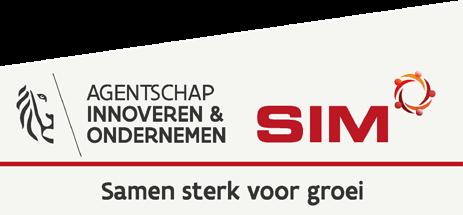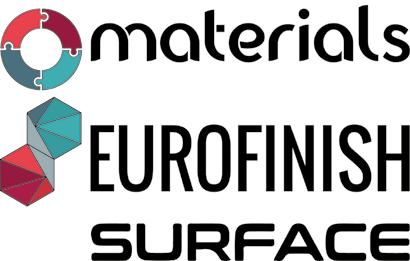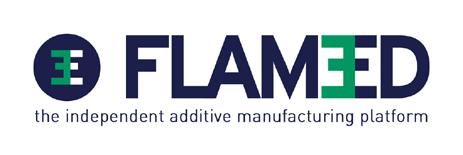ASSEMBLING MATERIALS USING CHARGED POLYMERS

IMPROVING PLASTIC WASTE SEPARATION WITH MAGNETIC FIELDS
BATTERIES CHARGE FASTER WITH NICKEL NIOBATE
POLYMER GIVES 3D-PRINTED SAND SUPER STRENGTH
DUTCH DESIGN WEEK 2021

Nummer 6 2021











4TU.HTM Research Programme New Horizons in Designer Materials | Visibility and accessibility of Materials Science & Engineering | Annual symposium Dutch Materials | 4TU.Joint Materials Science Activities | web application http://hightechmaterials.4tu.nl www.4tu.nl/htm @4TU_HTM High-Tech Materials form the key to innovative and sustainable technology http://hightechmaterials.4tu.nl Select key words and find relevant materials scientists or research groups within 4TU.
About
Innovatieve Materialen (Innovative Materials) is a digital, independent magazine about material innovation in the fields of engineering, construction (buildings, infrastructure and industrial) and industrial design.
A digital subscribtion in 2022 (6 editions) costs € 42,15 (excl. VAT)
Members of KIVI and students: € 25,- (excl. VAT)
SJP Uitgevers
Postbus 861
4200 AW Gorinchem tel. +31 183 66 08 08 info@innovatievematerialen.nl
Publisher
Gerard van Nifterik
Advertizing & sponsoring
Drs. Petra Schoonebeek ps@innovatievematerialen.nl
Innovative Materials platform:
Dr. ir. Fred Veer, prof. ir. Rob Nijsse (Glass & Transparency Research Group, TU Delft), dr. Bert van Haastrecht (M2I), prof. Wim Poelman, dr. Ton Hurkmans (MaterialDesign), prof.dr.ir. Jos Brouwers, (Department of the Built Environment, Section Building Physics and Services TU Eindhoven), prof.dr.ir. Jilt Sietsma, (4TU.HTM/ Mechanical, Maritime and Materials Engineering (3mE), Kris Binon (Flam3D), Guido Verhoeven (Bond voor Materialenkennis/SIM Flanders, Prof. dr. ir. Christian Louter (Institut für Baukonstruktion Technische Universität Dresden).
10 Research
18 Assembling materials using charged polymers
Soft matter can be found in many everyday materials, such as food, cosmetics, and the cells in the human body. The structure of these tiny, soft materials is determined by various interactions, one of which is electrostatic interaction. For his PhD research, Christian Sproncken used electrostatic interactions to assemble soft materials into various structures consisting of charged polymer chains. These materials could be used in responsive coatings for photonic microchips, or in materials to stop ice growth on car windshields or airplane wings. Sproncken completed his research at the Laboratory of Self-Organizing Soft Matter under the supervision of Ilja Voets. On October 26, he defended his dissertation at the Faculty of Chemical Engineering and Chemistry at Eindhoven University of Technology.
20 Improving plastic waste separation with magnetic fields
Plastic materials can be separated with magnetic density separation, which can separate plastic materials using magnetic fields, but this technique is not always effective. Rik Dellaert studied flows of plastic particle mixtures in wind tunnels to assess the effect of turbulence on the separation process. He’ll defend his PhD thesis on November 26th at the department of Applied Physics.
22 Batteries charge faster with nickel niobate
By using a fully new material, nickel niobate, for the anode of lithium-ion batteries, the charging speed can be improved by ten times, according to researchers of the University of Twente (MESA+ Institute). This is possible without the risk of damaging the anode material, causing battery breakdown or reducing its lifetime. An additional advantage is that the manufacturing process is not complicated. The researchers published their first results using batteries with the new anode in the Advanced Energy Materials journal.
24 Polymer gives 3D-printed sand super strength
Researchers at Oak Ridge National Laboratory's (ORNL) Department of Energy have developed a new polymer to bind and reinforce 3D printed silica sand. The polymer is added in binder jetting, a 3D printing method, such as used in the manufacturing industry. The study demonstrates a 3D printed sand bridge that at 6.5 centimeters can hold 300 times its own weight.
28 Dutch Design Week 2021
Every year in October the Dutch Design Week (DDW) takes place in Eindhoven. Between 16 and 24 October, the largest design event in Northern Europe presented the work of over a hundred designers, spread over more than a hundred locations in the city. With the theme The Greater Number, Dutch Design Week (DDW) called for a critical look at our way of producing and consuming this year. The largest design festival in Northern Europe showed how much designers are trying to find the right balance, towards less or towards more but better. And again this year attention is paid to material innovations, 3D-printed materials and objects, biomaterials and above all a lot of circularity.
CONTENT INNOVATIVE MATERIALS 6 2021
Cover: Radiolaria created by Lilian van Daal was presented at the Dutch Design Week 2021 (page 32)
News
2
Plastic Scanner wins James Dyson Award
Delft Design alumnus Jerry de Vos has won the prestigious James Dyson Award sustainability prize, with the Plastic Scanner he designed. The Plastic Scanner is a handheld scanner that can quickly determine what kind of plastic something is made of. This information is important for reuse and recycling of the worldwide growing plastic waste.
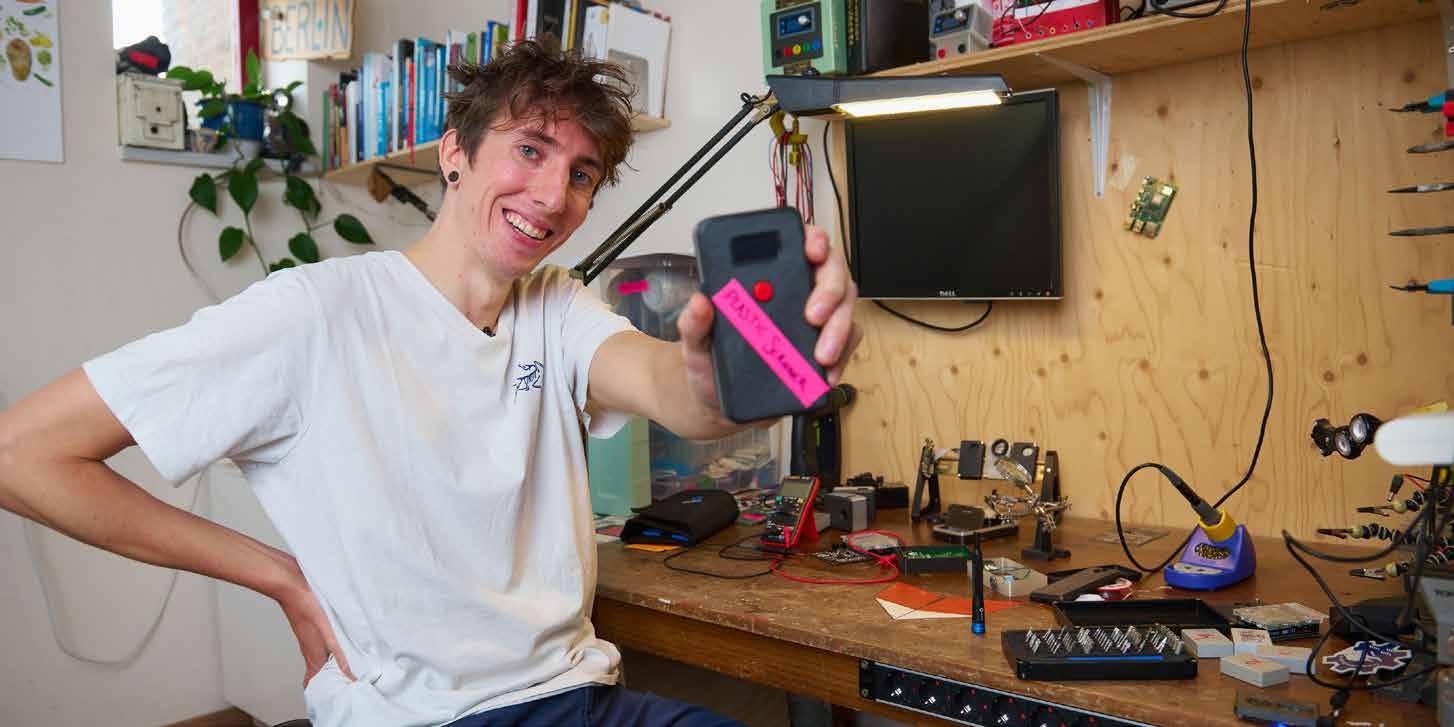
Plastic is a lightweight, safe and readily available material which can be used to make long-lasting, durable products. It’s often not really recyclable and so ends up in landfill, or worse on the beach or in our oceans. However, with the right technologies plastics could be widely recycled successfully at end of life and transformed into new products, which themselves are long-lasting and durable.
The Plastic Scanner, invented by Integrated Product Design MSc graduate Jerry De Vos the TU Delft Faculty of Industrial Design Engineering, is a handheld device

that when held against a plastic composite will tell the user what materials it’s made from, using infrared light to detect the plastic components.
He developed the portable plastic scanner for his MSc thesis project using near-infrared spectroscopy, a technology that can categorize more than 75% of the plastics used in daily life. The device serves as an open source project, whose components can be sourced and manufactured locally. The Plastic Scanner thus helps to correctly separate plastics manually for better quality end products for reuse. Especially important because globally, a lot of waste separation is still done by hand.
The project uses the open source GPL-v3 license, which means that third parties are free to use the project, provided that this right is also passed on to others and the author(s) are mentioned. The Plastic Scanner builds upon Armin Straller's Re-
ReMeter project (see video), by applying the technology in a portable form. This design was the basis for Jerry to eventually make the Plastic Scanner into a tangible product by continually iterating and improving it with, for example, a mini-computer, battery, screen, button and the housing of the final prototype.
More at TUD>
2 | INNOVATIVE MATERIALS 6 2021 NEWS
Video
Wij leveren complete installaties voor ontstoffing, luchtreiniging en pneumatisch transport
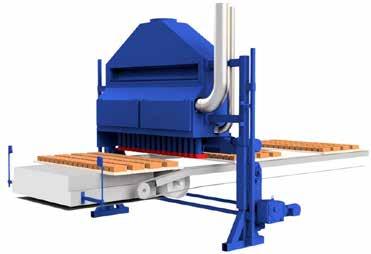

Technieken voor o.a.:
- Ontstoffing van productieruimtes (MAC)
- Reduceren van geuremissies (NER)
- Reduceren van stofemissies (NER)

Componenten die wij o.a. kunnen leveren:
- Natfilters & Droogfilters
- Cyclonen
- Gaswassers
- Topsteen- / Frogreinigers
- Naverbranders
Projecten kunnen turn-key worden uitgevoerd
Wij garanderen de emissie & grenswaarden
Engineering, bouw en onderhoud in eigen beheer

Mesys Industrial Air Systems BV
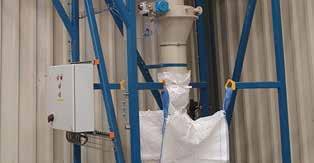




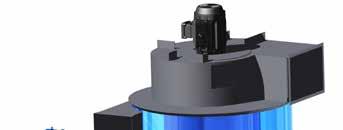

Molenstraat 27, 6914AC Herwen
Info@mesys.nl
www.mesys.nl +31 (0) 316 248744

Integer, onafhankelijk, objectief onderzoek en advies. ISO 17025 geaccrediteerd.
Wij helpen u graag verder met onderzoek en analyse van uw innovatieve materialen.
Bel ons op 026 3845600 of mail info@tcki.nl www.tcki.nl
NEWS
Hoog vacuüm stofzuiginstallatie
Natfilter met slibtransporteur
Frogreiniger
Hét expertisecentrum voor materiaalkarakterisering.
Wind turbines made with fabric
Enel Green Power has launched a partnership with the Scottish startup ACT Blade to develop a new type of innovative wind turbine made of fabric, capable of generating more energy, reducing costs and making it easier to recycle its component materials.

ACT Blade specializes in the production of innovative wind turbines covered with a special technical fabric, based on the principles adopted for the sails used by boats competing in the America’s Cup. This technology has great potential for the wind power industry as well, because it could bring significant benefits in both economic and environmental terms. First of all, the turbine blades
are lighter because they have a slender supporting structure made of composite material that is completely covered with the technical fabric. The new blades with the same weight as conventional ones are longer and therefore ensure an increased production of electricity. In addition, the costs are lower thanks to other features, such as a structure that is composed of fewer materials in relation to its length, as well as modular production processes that are simpler and more streamlined, leading to expected savings of up to 17%.
Finally, a particularly relevant aspect concerns the circular economy. The ACT Blade rotor blades are made of a
reusable fabric and from elements that are more easily separable compared with conventional blades, so they can be recovered more easily once the blades are dismantled at the end of their useful life.
According to Enel Green Power ACT Blade’s technology fits perfectly with Enel’s strategy for the circular management of wind farms: maximizing the reuse and recycling of materials and components and applying a circular perspective right from the design phase.
4 | INNOVATIVE MATERIALS 6 2021 NEWS
Not a subscribtion yet? Send an email to info@innovatievematerialen.nl
More at Enel Green Power>
Flexi-Loft
During the Automotive Acoustics Conference, which will be held virtually on November 16 and 17, 2021, Autoneum high lighted her Flexi-Loft technology. Flexiloft is a lightweight material made of recycled cotton and functional fibres for vehicle interiors. Autoneum headquartered in Winterthur, Switzerland, is specialized in acoustic and thermal management solutions for the automotive industry.
Flexi-Loft is a new felt-based technology that, thanks to a special blend of recycled cotton and functional fibers, has a lower weight and allows precise adjustment, even in complex applications. The textile material thus offers a versatile
and more sustainable alternative to foam.
Because felt-based materials are generally less bulky and mouldable than foam components, they require more weight to thoroughly fill the areas of varying thickness between the part's surface and the white body of the vehicle.
According to Autoneum, Flexi-Loft is significantly lighter, more flexible and more adaptable than standard felt for acoustic car interiors. In addition, according to the manufacturer, the fiber-based material outperforms current foam products in terms of durability.
Flexi-Loft consists of at least 50% recycled cotton fibres, and cut-offs generated

during the manufacturing process are reclaimed, processed and then reused in the production of new felt blanks. Furthermore, the material is fully recyclable.
Autoneum profiles itself as the global market and technology leader in acoustic and thermal management solutions for vehicles. The company develops and produces multifunctional, lightweight components for noise and heat protection. The products and technologies are intended to make vehicles quieter, safer and lighter.
5 | INNOVATIVE MATERIALS 6 2021 NEWS
www.autoneum.com
100% biobased binder as a sustainable alternative for bitumen in asphalt

Developing a 100% biobased binder for asphalt. That is the aim of a three-year research project of Wageningen Food & Biobased Research, H4A, Roelofs, AKC and TNO. The new binder will be based on biobased components from side streams of the paper and pulp industry and the agri-food industry.
Wageningen Food & Biobased Research has been working on sustainable alternatives for existing asphalt binders for years. There are currently 25 test sections around the Netherlands with varying compositions in which 50% of the bitumen was substituted by lignin. In practice, a partial replacement of bitumen with the natural binder lignin has yielded significant gains in sustainability.
Other biological molecules
The primary goal is for the new asphalt binder to have at least the same functional properties as bitumen. According to Richard Gosselink, lignin expert and coordinator at Wageningen Food & Biobased Research, the properties that are required must be translated into the biobased components that the researchers want to use. In order to get the functional properties, they are looking for smart combinations of biological molecules from a previously compiled longlist. The research first focuses on lab research to find the right combinations of molecules. Various components will probably need
to be modified in order to give them the desired functional properties.
Asphalt test strip
With this project, the project partners aim to give the market a significant boost towards a bitumen-free asphalt binder. One of the preconditions for the new asphalt binder is that the biobased raw materials required must be abundant. The aim is to deliver a test strip within three years, on which the new asphalt binder has been incorporated and which is suitable for further upscaling. This test strip will also be tested exten-
sively in order to generate the required data and to work towards a introduction on the market.
Consortium
This project, with number BBE-2006/ LWV20.045, sees a collaboration between Wageningen Food & Biobased Research, H4A, Roelofs, AKC and TNO. The partners are grateful to the Ministry of Economic Affairs and Climate Policy for the necessary TKI supplement funding.
More at WUR>
6 | INNOVATIVE MATERIALS 6 2021 NEWS
Photo: WUR
Not a subscribtion yet? Send an email to info@innovatievematerialen.nl
Rabobank Innovation Challenge 2021
Takkenkamp, Straw Blocks Systems and Signify are the winners of the Rabobank Innovation Challenge 2021. The prizes were awarded on Tuesday 2 November on the first day of the innovation event Building Holland in RAI Amsterdam. A total of fifteen products were nominated. With the Rabobank Innovation Challenge, Rabobank and Building Holland want to stimulate innovation in the construction sector.
Signify was awarded an award with NatureConnect in the category Smart & Healthy. NatureConnect is a revolutionary form of lighting for offices, hospitals and other commercial buildings. Two of the winners received the prize for innovative use of materials. Takkenkamp won in the Energy Transition category with Airofill Innovative Wall Insulation: a kind of slurry based on aerogel, which can be easily applied through holes in the joint. The slurry becomes liquid with movement, but stiffens in the cavity and stabilizes in the wall. Takkenkamp Isolatie says it can achieve an Rc value of 3.20 with a cavity wall of 6 cm..
Takkenkamp>
In the category Circularity, the prize went to Straw Blocks Systems. The company makes prefab building blocks of pressed straw. The profile consists of tongue and groove so that the blocks interlock. This makes it possible to realize flat, strong and stable walls with pressed straw with a minimum of (relatively expensive) construction parts. Due to the perfect fit, there are no significant thermal bridges or material tensions and the risk of leaks in the insulation is zero. The standard size is 40 x 40 cm (h x w). The length depends on the application or wishes of the client and can vary from 40 to 120 cm. The density is 125 kg/m3. Building elements are assembled from

these pressed straw blocks. On the outside there are construction parts made of wood or other material, depending on the application. The outside of the elements is provided with a (maximum
1 centimeter thick) clay layer as standard, with which the material meets the standards with regard to fire retardancy.
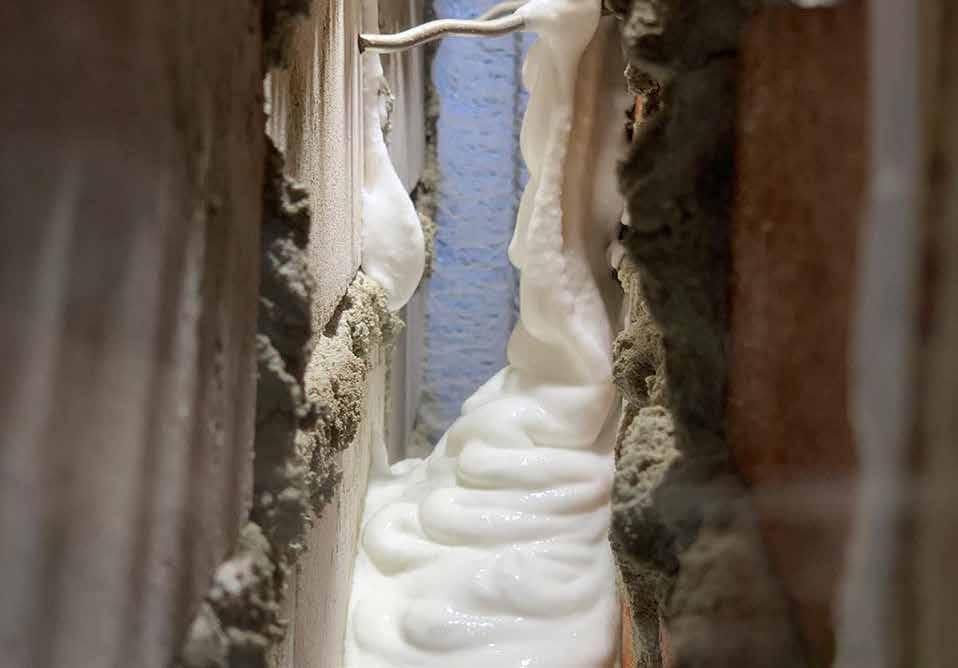
7 | INNOVATIVE MATERIALS 6 2021 NEWS
Strawblocks>
Above: Aerofill; below: Strawblocks
GeoDuct: a natural circular viaduct
Infrastructure projects typically bear a sizeable ecological footprint and often lead to significant environmental impact due to the extraction, processing, and transport processes. At the same time, large segments of existing Dutch infrastructure must be replaced and/or renovated (Replace & Renovate programme). The Directorate-General for Public Works and Water Management (Rijkswaterstaat) has set its objective to become fully circular from 2030 and has appealed to the market via the SBIR Programme (Strategic Business Innovation Research) to develop innovative circular viaducts that can be reused repeatedly. The project is a collaboration between Architectenbureau ZJA, Iv-Infra, Dura Vermeer, Geotec Solutions, HUESKER Nederland and Ploegam BV.
The GeoDuct is a viaduct built entirely from area-specific, local soils confined within geotextiles. The natural curve of the arch distributes the forces and eliminates the need for a pile foundation. The soils are not bound or mixed, and the geotextile can be recycled, biobased or designed to be fully removable. Thus, resulting in a lower environmental impact in terms of circularity and CO₂
emissions.
According tot the project team, the lower environmental impact with regard to circularity stems from the use of primary and secondary materials. The GeoDuct uses 95% less primary materials compared to a traditional viaduct made of concrete and steel. And because the GeoDuct is 100% removable, the raw materials are highly reusable, unlike concrete reinforced with steel. When steel-reinforced concrete reaches the end of its lifespan or is removed, it no longer retains the value of primary raw materials and can only be recycled.
The use of materials largely determines the CO₂ emissions of a viaduct. The production of materials such as concrete and steel generates high levels of CO₂ emissions. When geotextile and soil are used, these emissions are significantly reduced or not even applicable, respectively. Based on indicative calculations, the development (production materials + construction site activities) of the GeoDuct emits 50% less CO₂ than a conventional viaduct made of concrete and steel.
Another interesting element is the connection between the natural soil

and a circular civil enginering structure. Rob Torsing, partner architect at ZJA remarked: ‘A bridge that merges into the landscape at the end of its life, and slowly disappears as if it was never there. That is circularity at its best.’
ZJA is investigating what this new construction method means for the architectural idiom of public works and their spatial impact. Reinforced ground constructions entail a different aesthetic than those made of steel or concrete, for example. ZJA considers it a challenge to develop a new architectural idiom, appropriate to this new technology for creating spans that connect people and places.
According to the project partners, he constructive feasibility of the GeoDuct has already been demonstrated mathematically. Currently the team is further developing the design, in order to build a prototype. If these test findings are good, the concept should be sufficiently proven to be included in innovative procurement projects. The team can then complete the remaining detailed engineering within the first commercial project.
More at ZJA>
8 | INNOVATIVE MATERIALS 6 2021
Prof. Arjan Mol new scientific director 4TU.HTM
As of 1 January 2022, Prof. Arjan Mol (Delft University of Technology) will be the new scientific director of the 4TU.Centre High-Tech Materials (4TU.HTM). He succeeds Prof. Jilt Sietsma, who was one of the initiators of 4TU.HTM and has led the centre since its inception in 2014.

4TU.HTM aims to stimulate and innovate excellent materials science research at the four universities of technology (TUs) in the Netherlands (Delft, Eindhoven, Twente, Wageningen) through collaboration and new initiatives in the fields of research and education. Recently, 4TU.HTM and the other centres of the 4TU.Federation were given the green light to continue their activities in the period 2022-2025.
Sietsma: 'What I really like is how 4TU.HTM has expanded due to the participation of WUR. Materials science is not just about steel, composites and concrete; the soft materials from Wageningen are just as much a part of it.'
Mol: 'We are faced with complex challenges with the materials and energy transition. The better organised we are as Dutch materials science community, the more society as a whole can benefit from our expertise.'
Mol has been professor of Corrosion Technology and Electrochemistry at Delft University of Technology since 2017, where he also obtained his PhD in 2000. His research focusses on corrosion mechanisms and (environmentally friendly) ways to prevent corrosion.
In addition to the activities of 4TU.HTM that started earlier, Mol specifically wants to support young scientists who have yet to build up their network: 'In the coming years, we will discover how big the impact of corona is on the careers of the new generation of scientists. I want to make sure that they can still make the necessary connections, within and outside their field of expertise,' says Mol. He also aims to work on in-
creasing public support for the field: 'Without materials science it would be darn empty around us.'
In addition to the scientific director, the organisation of 4TU. HTM consists of a Management Team in which all TUs are represented, and a coordinator.
Read more: interview with Arjan Mol and Jilt Sietsma>
Since 2017, Arjan Mol has been professor of Corrosion Technology and Electrochemistry at the Faculty of Mechanical, Maritime and Materials Engineering (3mE), Delft University of Technology, where he also obtained his PhD in 2000. His research focusses on corrosion mechanisms and (environmentally friendly) ways to prevent corrosion. This work is relevant for applications ranging from offshore to aircraft construction and from microelectronics to the automotive industry. Mol is Past President of the European Federation of Corrosion (EFC), Honorary Professor at the University of Science & Technology Beijing (China) and Editor-in-Chief of Elsevier's Corrosion Science.
9 | INNOVATIVE MATERIALS 6 2021 NEWS
Prof.dr.ir. Arjan Mol
Running shoe material inspired 3D-printed design to protect buildings from impact damage
A material used in running shoes and memory foam pillows has inspired the design of a 3D-printed product that could help protect buildings from collision damage and other high impact forces, like shock energy caused by gas explosions, earthquakes and wind forces. Dr Tatheer Zahra from the Queensland University of Technology (QUT) Centre for Materials Science used off-the-shelf material to 3D print geometric shapes that mimic the behaviour of auxetic materials. Her work was published on September 30 in Smart Materials and Structures.

Auxetics are structures or materials that have the property that when stretched, they become thicker perpendicular to the applied force. This occurs due to their particular internal structure and
the way this deforms when the sample is uniaxially loaded. Such materials or structures have special mechanical properties, like high energy absorption and fracture resistance. Auxetics may be useful in applications such robust shock absorbing material, like running shoes.
According to dr Zahra 3D printing auxetic geometries could potentially replace steel and fibre reinforced polymer mesh reinforcements in composites, and could also be used as a flexible and widely applicable protective wall render. She said the energy absorption would be equivalent to a 20 mm thick reinforced composite protective render over a full-scale building wall, which could potentially withstand the impact force of a car travelling at 60 km/hr. Now that the potential of the material
has been demonstrated in the lab, the designs will soon be tested in full scale.
More at QUT>
Video: A 180 g auxetic geometry resists 25kN force (approx. 2500 kg) by contracting in all directions to absorb energy of around 260 J without showing damage or changes in shape when released. If scaled-up, these geometries may be useful in saving buildings and other structures from collision impact
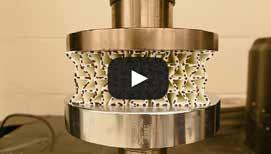
10 | INNOVATIVE MATERIALS 6 2021
Dr. Tatheer Zahra (Photo: Queensland University of Technology)
Self-healing ‘living materials’ used as 3D building blocks
Scientist of the Imperial College London have created ‘living’ 3D building blocks that can heal themselves in response to damage. So-called Engineered Living Materials (ELMs) exploit biology’s ability to repair material in response to inflicted damage. According to Imperial this could lead to the creation of real-world materials that detect and heal their own damage, such as fixing a crack in a windshield, a tear in the fuselage of an aircraft or a pothole in the road. Integrating the building blocks into self-healing building materials could reduce maintenance in the future and increase the lifespan and usability of a material. This work was published in Nature Communications on August 19th.
To create ELMs, the researchers used genetically engineered bacteria to have them produce fluorescent 3D sphere-shaped cell cultures, known as spheroids, and to give them sensors which detect damage. They arranged the spheroids into different shapes and patterns, demonstrating the potential of spheroids as modular building blocks. They used a thick layer of bacterial cellulose, an organic compound produced by certain types of bacteria. They damaged the material by making holes in it and then inserted the freshly grown spheroids into the holes. After incubating them for three days, it appeared that the material appeared to have repaired itself excellently.
According to the scientists this discovery opens a new approach where grown materials can be used as modules with different functions like in construction. By placing the spheroids into the damaged area and incubating the cultures, the blocks were able to both sense the damage and regrow the material to repair it. The discovery also opens up to allow cultured materials to play a role as modules with different functions, such as in construction.
The research should be seen in light of the growing scientific interest in bacterial cellulose.
Bacterial cellulose is produced by some types of bacteria to form protective envelopes around the cells. It has different properties from plant cellulose and is characterized by high purity, strength, moldability and increased water holding ability. Although bacterial cellulose is produced in nature, many methods are currently being investigated to enhance cellulose growth from cultures in laboratories as a large-scale process. By controlling synthesis methods, the resulting microbial cellulose can be tailored to have specific desirable properties, which could be the basis for the development of a whole new class of functional materials.
The next step is to develop new spheroid building blocks with different properties, such as combining them with materials like cotton, graphite and gelatins to create more complex designs. This could lead to new applications like biological filters, implantable electronics or medical biosensor patches.
‘Bacterial cellulose spheroids as building blocks for 3D and patterned living materials and for regeneration' by Ellis et al., was published 19 August 2021 in Nature Communications. It’s online>
www.imperial.ac.uk>

11 | INNOVATIVE MATERIALS 6 2021 RESEARCH
Researchers saw excellent repair that was structurally stable and restored the consistency and appearance of the material
New way to capture CO2
Worldwide efforts are being made to limit CO2 emissions, and one of the instruments to achieve this is CO2 capture. The techniques used to do this are mainly based on liquid processes. The most widely used method is to capture the CO2 from the flue gas and channelling it into a liquid. The flue gas or biogas is passed through long pipes to a large quantity of liquid - typically water - which contains various additives that help absorb the CO2 in the liquid. Once the CO2 has been absorbed in the liquid, it has been captured. This is an efficient method, but also highly energy-consuming.
At Technical University of Denmark (DTU), recently developed a new and more energy-efficient method that can capture the CO2 in a solid material and upgrade it to a cleaner product, which can subsequently be used to produce, for example, fuels.
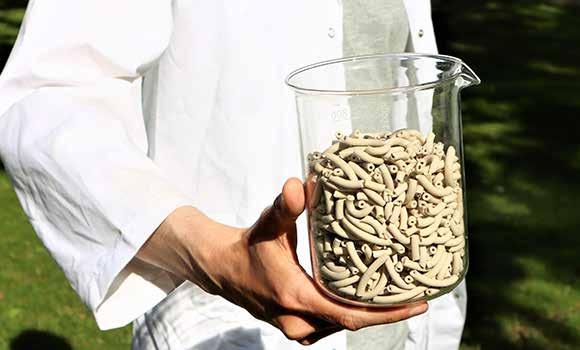

The researchers used a solid material that has ionic liquid1 in its pores. The ionic liquid binds the CO2 - and when the material has been saturated with CO2 - the CO2 can subsequently easily be released through a combination of slight heating and lowering of the pressure.
According to the scientists one of the key advantages of using an ionic liquid is that it does not evaporate into gas when it is heated or the pressure is lowered, and it therefore remains in the solid material, which can be reused in the carbon capture unit. This avoids heating and pumping of excess liquid in the plant. The researchers hope to be able to capture up to 90 per cent of the CO2 from
the biogas with an energy consumption that is less than half of that of the methods most commonly used today. The actual carbon capture unit with the new technology will be installed and tested as a demonstration project at one of Wärtsilä’s biogas plants in Sweden, where it will purify part of the biogas produced.
The tests take up to six months and have
12 | INNOVATIVE MATERIALS 6 2021 RESEARCH
Photo: DTU
to demonstrate whether the material continues to capture and release CO2 efficiently. Both the materials and the process have been patented.
Source: DTU>
1 An ionic liquid (IL) is a salt in the liquid state. In some contexts, the term has been restricted to salts whose melting point is below some arbitrary temperature, such as 100 °C. While ordinary liquids such as water and gasoline are predominantly made of electrically neutral molecules, ionic liquids are largely made of ions>
On the right: The material with the ionic liquid is shaped as small tubes. According to Professor Anders Riisager, the carbon capture testing of the biogas production at the plant in Sweden will be performed with approx. 10 kg of the material (Illustration: DTU Chemistry)
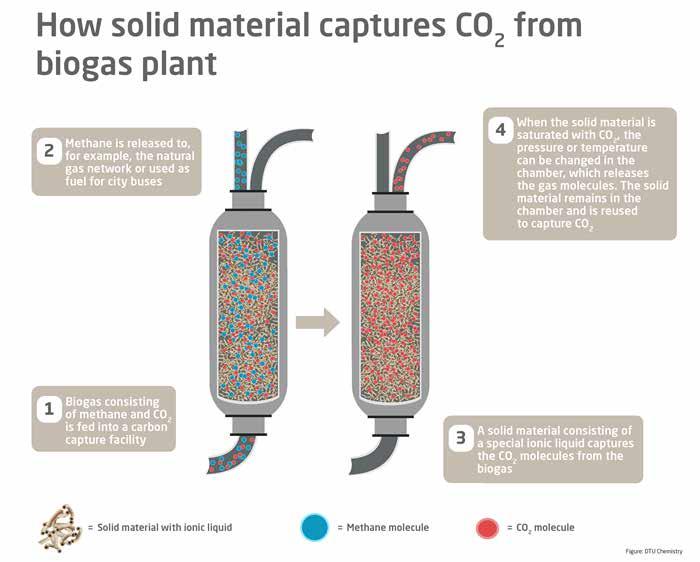
Silicon carbide synthesis based on wood processing waste
Scientists of National University of Science and Technology MISIS in Moscow have developed an easy and cost-efficient method for obtaining industry-grade silicon carbide from wood processing waste. The study was published in Materials Chemistry and Physics.
Silicon carbide is a hard, synthetically produced crystalline compound of silicon and carbon. Silicon carbide is nearly as hard as diamond, wear-resistant, heat and radiation proof.
The material is widely used in the metal industry and in the manufacture of high-temperature bricks and other refractory materials. In addition, silicon carbide crystals are used in grinding wheels, sandpaper, the jewelry industry, construction, the production of bullet-proof vests, car parts such as brakes and much more.
Interesting are so-called biomorphic carbides, which are made from carbon obtained from wood. Several biomorphic carbides have already been developed from different woods and even cereals: beech, oak, pine, linden, maize and millet. Recently, attempts have even been made to synthesize biomorphic silicon carbide from various industrial materials such as fiberboards, paper and wood composite boards. However, current technologies of biomorphic silicon carbide production are imperfect. The properties of the synthesized products are often unpredictable. In addition, the conventional methods of producing silicon carbide from charcoal are time consuming.
Scientists from NUST MISIS and Tomsk Polytechnic University have come up with a method for obtaining high-quality silicon carbide from charcoal and silicon
in plasma of direct current low-voltage arc discharge in ambient air using an electric-arc reactor with graphite electrodes.
It was found that the three-fold arc processing during 25 - 30 seconds each at a current of 220 A allows a complete transformation of initial silicon into its carbide.
An important advantage of the proposed method is the simplicity of the synthesis process, which doesn’t require a sealed chamber, inert gases or a vacuum pump. Another important advantage is that synthesis takes very little time (from seconds up to several minutes) compared to the conventional methods. And last but not least, the raw carbon material is renewable and comes from wood (waste).
More at NUST MISIS>
13 | INNOVATIVE MATERIALS 6 2021 RESEARCH
Sustainable glitters
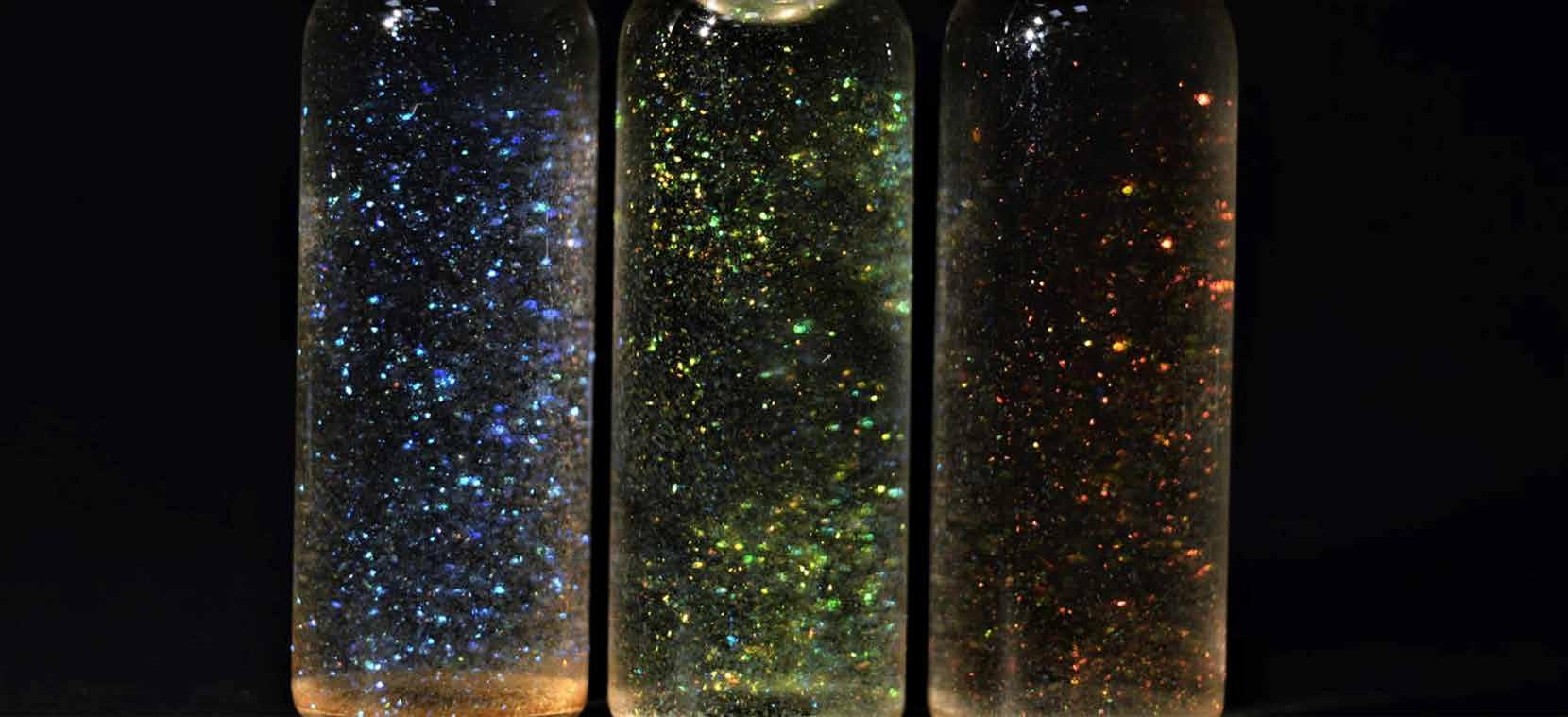
Cambridge researchers have developed a sustainable, plastic-free glitter for use in the cosmetics industry - made from the cellulose the main building block of cell walls in plants. There are thousands of types of glitter, most commonly made from ultra-thin, multi-layered sheets that contain plastics as well as dyes and reflective materials such as aluminium, titanium dioxide, iron oxide and bismuth oxychloride. These sheets are then cut into small particles. Some experts warn that glitter poses a threat to the environment, contributing to microplastic pollution.
The sustainable Cambridge kind of glitter is made from cellulose nanocrystals, which can bend light in such a way to create vivid colours through a process called structural colour. The same phenomenon produces some of the brightest colours in nature - such as those of butterfly wings and peacock feathersand results in hues that do not fade, even after a century. Using self-assembly techniques that allow the cellulose to produce intensely-coloured films, the researchers say their materials could be used to replace the plastic glitter particles and tiny mineral effect pigments which are widely used in cosmetics. In Europe, the cosmetics industry uses about 5,500 tonnes of microplastics every year.

After producing the large-scale cellulose films, the researchers ground them into particles of the size used for making glitters or effect pigments. The resulting particles are biodegradable, plastic-free and non-toxic. The researchers also say that they have succeeded in making the process suitable for industrial machines.
According to Camebridge, this is the first time these materials have been fabricated at industrial scale. Although further optimisation of the process is still needed, the researchers are
hoping to form a spin-out company to make their pigments and glitters commercially available in the coming years.
The results are reported in the journal Nature Materials, titled ‘Large-scale fabrication of structurally coloured cellulose nanocrystal films and effect pigments.’ Nature Materials (2021). DOI: 10.1038/s41563-021-01135-8
More at Cambridge>
14 | INNOVATIVE MATERIALS 6 2021 RESEARCH
PeLEDs : stretchy, bendy, flexible LEDs

Researchers of McKelvey School of Engineering, part of The Washington University in St. Louis (WUSTL), have developed a new material suitable to fabricate a new type of flexible LEDs. Organic LEDs (OLEDs) are made with organic molecules or polymer materials. They are cheap and flexible. Inorganic LEDs such as microLEDs are high performing, bright and very reliable, but rigid and very expensive. The new technology combines the best of existing LEDs and organic LEDs (OLEDs). In addition, the WUSTL researchers developed a novel way to fabricate it - using an inkjet printer. The research was published last November in the journal Advanced Materials.
The WUSTL scientists used a particular type of crystalline material: modified organometal halide perovskite. The traditional way to create a thin layer of perovskite, which is in liquid form, is to drip it onto a flat, spinning substrate: so-called spin coating. As the substrate spins, the liquid spreads out, forming a thin layer. From there, it can be recovered and made into perovskite LEDs, or PeLEDs. In this process a lot of material is wasted by spattering away. And so the idea of the inkjet printer was born. Inkjet fabrication saves materials, as the perovskite can be deposited exactly where it’s needed. The process turned out to be much faster as well, cutting fabrication time from more than five hours to less than 25 minutes.
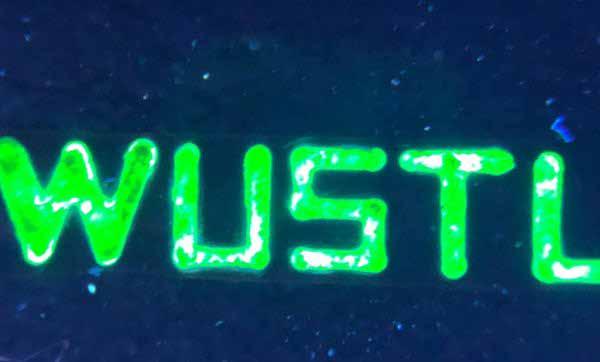
Another benefit of using the inkjet prin-

ting method is that perovskite can be printed onto a variety of unconventional, even flexible substrates. However, the capability of printing on a flexible material appeared not to be enough; the LEDs themselves had to be flexible as well. This problem was solved by embedding the inorganic perovskite crystals into an organic, polymer matrix made of polymer binders. This made the perovskite and, by association, the PeLEDs, elastic and stretchable. However, there were problems to overcome. LEDs are constructed in a sandwich-like configuration, with at least an emissive layer, an anode layer and a cathode layer. Because all parts of the PeLED were made from liquid,
the perovskite layer, as well as the two electrodes and a buffer layer, a major concern was keeping all of the layers from mixing. The team had to keep the perovskite layer safe from mixing with any of the others, the way running a highlighter over freshly written ink might smear it. So an suitable polymer has to been found, one that could be inserted between the perovskite and the other layers, protecting it from mingling while not interfering too much with the PeLED’s performance. After that was successful, the first stretchable PeLEDs could be printed effectively.
More at WUSTL>
15 | INNOVATIVE MATERIALS 6 2021 RESEARCH
Online Bijeenkomst Kring Materiaalbewerking met Lasers (BvM) – 26 januari 2022 Interesse? klik hier
MAKE IT MATTER MAKE IT MATTER
MAKE IT MATTER is compiled in collaboration with MaterialDistrict (MaterialDistrict.com). In this section new, and/or interesting developments and innovative materials are highlighted.

Popcorn 'polystyrene'
Researchers from the University of Göttingen (Germany) developed a polystyrene-like material developed from popcorn. It can be used as packaging and insulation material, with compostable and has water-repellent properties. The technology is based on processes similar to those used in the plastics industry. German cereal producer Nordgetreide has received a licence agreement for the commercial use of the process and products for the packaging sector. German construction company Bachl Group is licensed to use the process to make building insulation.


More at MaterialDistrict>
Roxipan
Roxipan is a decor panel with the appearance of concrete. Roxipan is adapted to both the construction and renovation of commercial, industrial, tertiary or private buildings. Wether smooth or not, water resistant or fire resistant, it is especially recommended for rooms with a high level of humidity. Roxipan panels are available in a variety of styles, smooth or rugged, plated on any support, MDF, plywood, chipboard, compact.
Stax
More at MaterialDistrict>
Stax consists of layers of glass which are stacked and then fused together to create solid panels. This special process enables Nathan Allan to create exterior feature walls over very large surfaces. To classify the material as safety glass, flat panels of clear, cast, mirror glass are laminated to the back of the Stax panels. The lamination is necessary as the Stax glass panels are too thick to temper, which is the usual treatment to make safety glass.
More at MaterialDistrict>
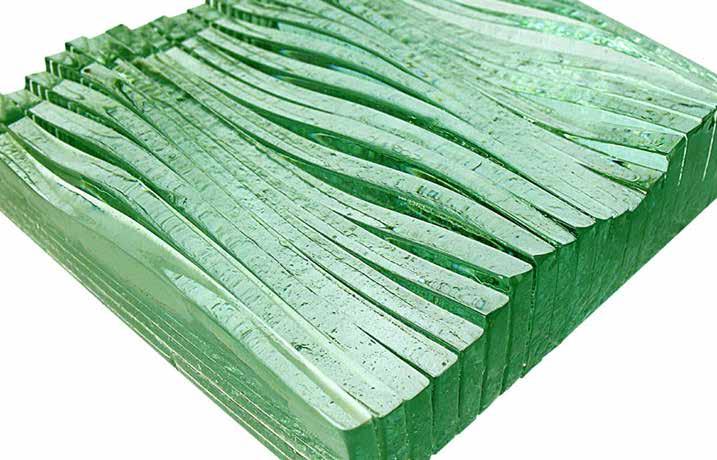
16 | INNOVATIVE MATERIALS 6 2021
MAKE IT MATTER
Balsaconcrete
Balsaconcrete is a lightweight material made of concrete with a core of foam. It can be used for tabletops, kitchentops, bathtubs and any other inside/outside panel or product that has to have the impact of concrete but not the heavy weight. Big sizes are possible, useable on any kitchenconstruction, available in all thicknesses, in any form and many colours.
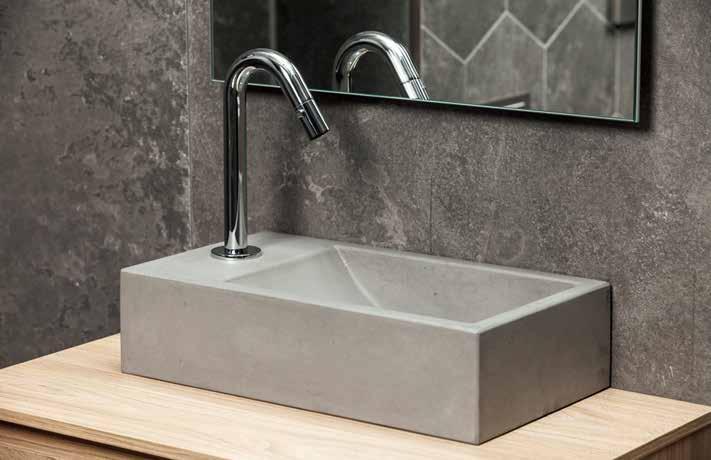
Photography: evolveproductions.nl
More at MaterialDistrict>
Timbercrete

Timbercrete is a building material, made of more than 50% by volume recycled sawmill waste. Homes made of this product consume less energy for heating/cooling. Timbercrete acts as a ‘carbon sink’ preventing the release of carbon dioxide from decomposing sawdust into the atmosphere. The material is fire resistant and can be used in a wide range of domestic, commercial, industrial and public buildings.
Zero
More at MaterialDistrict>
Zero brick is a material which delivers joint-free brickwork without coming into conflict with the basic rules of traditional bricklaying. ZERO has an extra large hollow at the top to which the mortar can be applied. This makes it possible to reduce the joint thickness to 4mm. The bricklayer can simply go about his work with a trowel and ordinary mortar.
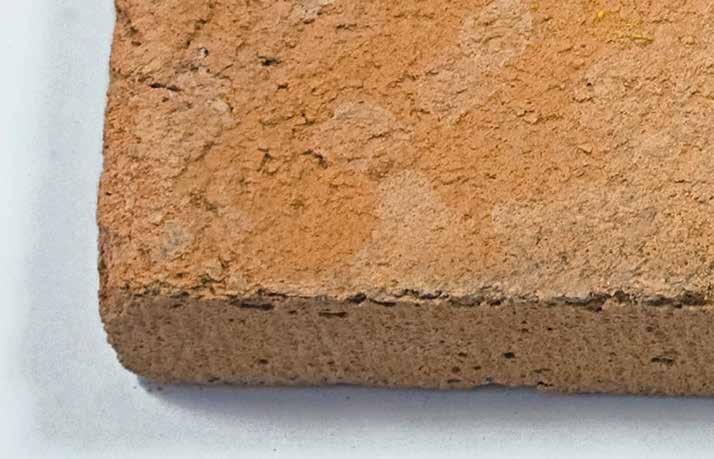
More at MaterialDistrict>
Plexwood - geometric
Geometric is a 2-layer wood product, consisting of a substrate with a Plexwood veneer on one side. Angled in 15, 30, 45 or 0/90, +15/-15, +30/-30, +45/-45 degrees, new surfaces appear, creating inspiring and unlimited possibilities.
More at MaterialDistrict>

17 | INNOVATIVE MATERIALS 6 2021
Assembling materials using charged polymers

Soft matter can be found in many everyday materials, such as food, cosmetics, and the cells in the human body. The structure of these tiny, soft materials is determined by various interactions, one of which is electrostatic interaction. For his PhD research, Christian Sproncken used electrostatic interactions to assemble soft materials into various structures consisting of charged polymer chains. These materials could be used in responsive coatings for photonic microchips, or in materials to stop ice growth on car windshields or airplane wings. Sproncken completed his research at the Laboratory of Self-Organizing Soft Matter under the supervision of Ilja Voets. On October 26, he defended his dissertation at the Faculty of Chemical Engineering and Chemistry at Eindhoven University of Technology.
Molecules of opposite charge attract each other, and this attraction can be used to build materials with interesting properties. Underpinning this attraction is electrostatic interaction, which is not only reversible but also tunable by varying solution properties such as salt concentration or pH. Using two polymers with opposite charges, various materials can be made by controlling how the polymers co-assemble via electrostatic interaction. For Christian Sproncken, the primary goal of his PhD research was to design and study the properties of materials made from oppositely charged polymers.
In his research, Sproncken was mainly interested in combining oppositely charged polymers to assemble new materials that could be used for various applications such as coatings in reprogrammable photonic materials and for materials with anti-freeze abilities.
The various studies, versatile approaches, and intriguing results featured in Sproncken’s PhD research demonstrate the potential of electrostatically co-assembled polymer-based soft matter systems for a wide variety of applications.
First, Sproncken prepared soft material coatings by dipping substrates in a
number of solutions containing polyelectrolytes, which are polymers that have an electrolyte or charged group. The resulting polymer network can undergo swelling and collapsing, depending on the acidity (pH) of the solution that the network is exposed to. By manipulating this exposure process, it is possible to create a dry polymer film with very low or very high porosity. The refractive index of the material depends on the material porosity, which makes this material ideal for applications in photonics.
Sproncken and Voets worked with Oded Raz and Mahir Mohammed from the department of Electrical Engineering at TU/e to create reprogrammable photonic microchips by coating microchips with the variable porosity material. For the next polymer assembly method, Sproncken and his collaborators included an ice-binding polymer in micelles, or colloidal particles, with a polyelectrolyte complex core. Attaching uncharged polymers prevents the cores from growing or fusing into large aggregates of uncontrollable size.
18 | INNOVATIVE MATERIALS 6 2021 INNOVATIVE MATERIALS
When this specific polymer binds to ice crystals, it can slow the growth of the ice crystals. It paves the way for materials that could prevent undesirable ice growth on the windshields of cars or the wings of airplanes.
The researchers found that the ice-binding activity of the polymer is maintained after inclusion in the micelles, making electrostatic co-assembly a promising tool as a basis for designing anti-icing materials.

In the middle of a clock reaction
Finally, Sproncken explored ways to control the interaction between oppositely charged polymers in solution. Direct mixing of oppositely charged polymers often leads to phase separation where there is a polymer dense phase and a polymer dilute phase. To stabilize the polyelectrolyte nanoscale structures, Sproncken used a reaction network to fix the size and shape of the polymeric nanoparticles. According to Sproncken, the operation of this reaction network is twofold. It tunes the interaction between the oppositely charged macromolecules while simultaneously stapling parts of the chains together.
In the future, such stable nanoparticles could be used as nanocarriers in biomedical applications, and it’s all possible thanks to a so-called clock reaction that prevents large unusable aggregates from forming.
On October 26, Sproncken defended his dissertation at the Faculty of Chemical Engineering and Chemistry at Eindhoven University of Technology, under the title 'Attractive Soft Matter: Polyelectrolyte Assembly for the Design of Functional Materials.’
Text: Eindhoven University of Technology>
A week of immersion in the world of 3D manufacturing!
POSTPONED TO 2022 – date to be announced, International multi-event – Benelux region
The International multi-event - 3D Delta Week - will be organized from 6 - 10 December 2021. The 3D Delta Week will create value for users and providers along the 3D Manufacturing Value Chain. It will be the 3D manufacturing meeting point for expert and layman, inside or outside the Benelux region.
The 3D Delta week is already gathering a dozen of renown events and will continue growing as the place-to-be, with activities aimed at specific sectors, at R&D and industry, at users and suppliers. The scheduling of events will allow participants to easily move from one activity to another.
The Benelux area (the Delta) is a top region in terms of 3D
production, with a myriad of academic and applied research centres, a particularly high number of 3D-printers and numerous promising start-ups and established enterprises. On the user side, the region boasts a multitude of application areas - all in all, an extremely versatile and high-quality ecosystem. Now, the appropriate podium has been created to bring this leading 3D production region to the fore.
The 3D Delta Week is an initiative initially set up by Brainport Eindhoven, Flam3D, Jakajima and Mikrocentrum.
www.3ddeltaweek.com
19 | INNOVATIVE MATERIALS 6 2021 INNOVATIVE MATERIALS
Improving plastic waste separation with magnetic fields


Plastic materials can be separated with magnetic density separation, which can separate plastic materials using magnetic fields, but this technique is not always effective. Rik Dellaert studied flows of plastic particle mixtures in wind tunnels to assess the effect of turbulence on the separation process. He’ll defend his PhD thesis on November 26th at the department of Applied Physics, TU Eindhoven.
Magnetic density separation has recently been developed by Umincorp. Magnetic density separation uses a ferrofluid that generates a vertical mass density gradient when in the presence of a magnetic field. In other words, as you move from the top of the fluid to the bottom, the apparent mass density of the fluid increases.
When plastic particles are added to this ferrofluid, the various particles move to a height in the fluid where the apparent mass density of the ferrofluid is about the same as the mass density of the
20 | INNOVATIVE MATERIALS 6 2021
Height differences of plastic particles inside a ferrofluid
plastic particles. Separated plastic can then be reused in higher-value products, and this significantly increases the economic feasibility of recycling. An example of such application can be seen in this video.
The separation process is occurring inside the magnetic density separator where, at the end of the machine, horizontal plates remove the fluid/ particle mixtures at different heights. The different mixtures contain different mass densities of plastic particles and the particles are then separated from the ferrofluid by a centrifuge resulting in plastic particles with a specific mass density range, which can be used as an indicator of the type of plastic in this mass density range.

This novel magnetic density separation technique comes with its own set of challenges. Turbulence inside the separation process reduces the separation efficiency due to increased mixing and should therefore be suppressed as much as possible. Secondly, particle collisions can delay the separation process.
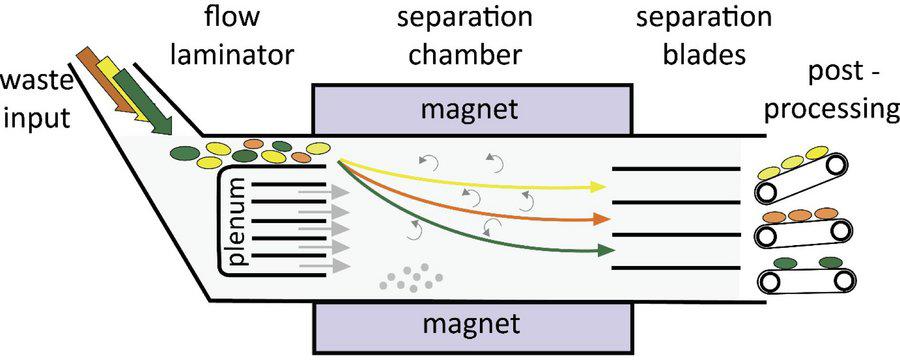
For his PhD research, Rik Dellaert set out to explore solutions to these challenges. First, he used two wind tunnels to measure and analyze the turbulence in the flow. Second, he used a fluid tank to track collisions between particles in a ferrofluid with a vertical mass density gradient in a magnetic field. From his research, a key recommendation by Dellaert is that a 'laminator' should be used at the entrance of the flow that consists of a collection of parallel square ducts to suppress turbulence. This so-called ‘laminator’ should have re-
latively small ducts and thin walls while maintaining a specific flow velocity. To explore the particle collisions that take place during the separation process, a numerical model was developed by Dellaert’s colleague Sina Tajfirooz. This model was successfully validated using experimental data from Dellaert’s experiments, which provided critical insight on the underlying processes in the magnetic density separator. These insights can be used to improve productivity and
efficiency.
Dellaert’s career is quite unusual. He started with a preparatory secondary vocational (vmbo) education, followed by a post-secondary vocational (mbo) education. He continued with a Bachelor of Applied Science (hbo) in Chemical Engineering, followed by a Pre-Masters and subsequently a Masters at the department of Chemical Engineering and Chemistry of Eindhoven University of Technology.
Text: TU Eindhoven>
The article ‘Turbulence and particle behavior in a magnetic density separation application‘ is online>

21 | INNOVATIVE MATERIALS 6 2021 INNOVATIVE MATERIALS
Schematic of the separation process
Magnetic density separator at the factory hall
Video
Batteries charge faster with nickel niobate
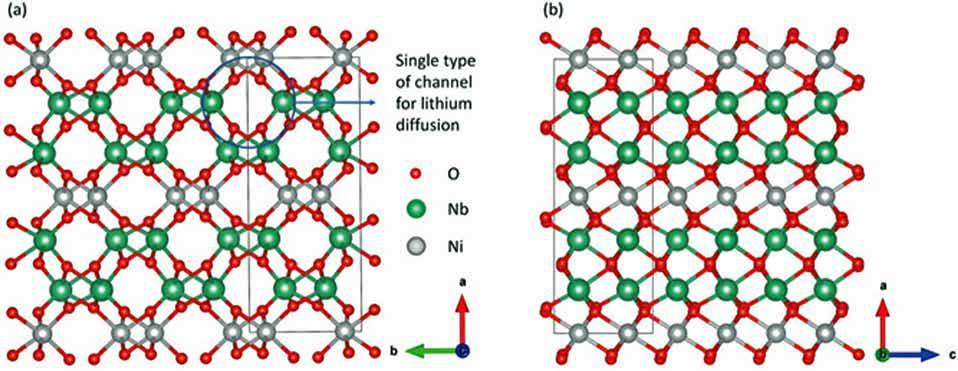
By using a fully new material, nickel niobate, for the anode of lithium-ion batteries, the charging speed can be improved by ten times, according to researchers of the University of Twente (MESA+ Institute). This is possible without the risk of damaging the anode material, causing battery breakdown or reducing its lifetime. An additional advantage is that the manufacturing process is not complicated. The researchers published their first results using batteries with the new anode in the Advanced Energy Materials journal.
Battery performance can still significantly be improved, whether it is for electric vehicles or for use in the electricity grid. Faster charging and decharging, or a higher energy density resulting in more compact and lighter batteries: often there is some kind of ‘trade-off’ of these two. The high-speed chargers by the motorway are an example of this dilemma. Not all cars and car batteries are prepared for this. Consequently, there is a worldwide search for new materials. An important aspect, next to the

22 | INNOVATIVE MATERIALS 6 2021 INNOVATIVE MATERIALS
The NiNb2O6 -host structure
technical specifications, is the need for drastically improving the sustainability and carbon footprint of battery production. The new material nickel niobate (NiNb2O6) appears to have very attractive properties and even after many cycles of ultrafast charging, it returns to its original level. This primarily has to do with its attractive ‘open’ and regular crystal structure, resulting in channels for charge transport that are identical.
Open structure
This means that it performs better than the standard anode material graphite. That is an ‘open’ material too, and it is simple. But after some cycles of highspeed charging, it will not return to the original level, or it will even break down. In the search for alternatives, at the University of Twente as well, new types of nano-structured materials are an option: a disadvantage, however, may be that the channels are organized in a
more random way. This may even cause deposit of lithium on the anode material, resulting in poorer performance after every cycle. Apart from that, manufacturing these materials is complicated. For nickel niobate, a cleanroom infrastructure is not necessary.
The high charging and decharging rates do have consequences for the weight and energy density, however. Nickel niobate is more compact than graphite, so it has a higher ‘volumetric’ energy density. The research team tested the first full battery cells with the new anode material, for various existing cathode materials as well. They conclude that this version would be ideal for introducing it into an energy grid, in electrically powered machines that require fast charging and decharging, or in electrically powered heavy transport. For using it in electrically powered cars, still some steps have to be taken. The new anode will also work
for alternatives for lithium, research leader Professor Mark Huijben says. The research was done at the Twente Centre for Advanced Battery Technology, part of UT’s MESA+ Institute, in collaboration with the Wuhan University of Technology in China and Forschungszentrum Jülich in Germany.
Text: University of Twente>
The paper ‘Nickel Niobate Anodes for High Rate Lithium-ion batteries’, by Rui Xia, Kangning Zhao, Liang-Yin Kuo, Lei Zhang, Daniel Cunha, Yang Wang, Sizhao Huang, Jie Zheng, Bernard Boukamp, Payam Kaghazchi, Congli Sun, Johan ten Elshof en Mark Huijben, was published today in Advanced Energy Materials. It is online>
Voeg informatie toe aan de Kennisbank
Biobased Bouwen
De Biobased Economy speelt een belangrijke rol in de duurzame ontwikkeling van Nederland en biedt nieuwe kansen voor het bedrijfsleven. Via de kennisbank kunt u kennis vergaren en delen over de beschikbaarheid en toepassingsmogelijkheden van biobased materialen, producten en bouwconcepten. Samen versterken we zo de biobased economie.
Ruim dertig partijen in de bouwsector ondertekenden de green deal biobased bouwen. Deze producenten, architecten, adviseurs en kennisinstellingen delen hun kennis rond kansrijke mogelijkheden van biobased bouwen. Ook de ministeries van Binnenlandse Zaken (Wonen en Rijksdienst), Economische Zaken, en Infrastructuur en Milieu ondersteunen de green deal.
Bouw ook mee aan de biobased economie en voeg uw project- of productbeschrijvingen toe aan deze kennisbank.
Kijk op www.biobasedbouwen.nl voor meer informatie>

23 | INNOVATIVE MATERIALS 6 2021 INNOVATIVE MATERIALS
advertentie.indd 1 1-2-2016 15:58:48
Polymer gives 3D-printed sand super strength
Researchers at Oak Ridge National Laboratory's (ORNL) Department of Energy have developed a new polymer to bind and reinforce 3D-printed silica sand. The polymer is added in binder jetting, a 3D printing method, such as used in the manufacturing industry. The study demonstrates a 3D printed sand bridge that at 6.5 centimeters can hold 300 times its own weight.

Binder jetting is a 3D printing technique in which powder particles are bonded together with a liquid binder. The binder, not the powder comes from the inkjet printhead. The powder cover is replenished after each layer. The binding polymer gives the printed sand its strength. The binder jet printing pro-
cess is said to be cheaper and faster than many other industrial 3D printing methods.
Parts printed via binder jetting are initially porous when removed from the print bed. They can be strengthened by infiltrating the design with an additional
super-glue material called cyanoacrylate that fills in the gaps. This second step provided an eight-fold strength increase on top of the first step, making a polymer sand composite stronger than any other and any known building materials, including masonry.
Parts formed with conventional binders
24 | INNOVATIVE MATERIALS 6 2021 INNOVATIVE MATERIALS
are made denser with infiltrate materials, such as super glue, but the Oak Ridge team instead used a newly developed polyethyleneimine or PEI binder. This doubled the strength of the sand compared to conventional binders. The PEI binder’s impressive strength stems from the way the polymer reacts to bond with cyanoacrylate during curing.
Silica sand is a cheap, readily available material that has been gaining interest in automotive and aerospace sectors for creating composite parts with sand casting moulds. However, today's sand casting moulds and cores have limited industrial application because they are prone to failure. Stronger sand parts are needed to support manufacturing at a large scale and enable rapid part production.
According to the ORNL researchers, the new high-strength polymer sand composite elevates the complexity of parts that can be made with binder jetting methods, enabling more intricate geometries, and widens applications for manufacturing and construction.
More at ORNL>
The research was published in Nature Communications in November titled ‘Additive manufacturing of strong silica sand structures enabled by polyethyleneimine binder.’ It is online>

5,6 & 7 April 2022 UTRECHT (WERKSPOORKATHEDRAAL)
The dates and location of MaterialDistrict 2022 are known. The event will move from March to April 5, 6 & 7 and from Rotterdam to Utrecht (Werkspoorkathedraal).

MaterialDistrict Utrecht (formerly Material Xperience) is the only annual event in the Netherlands that brings together material manufacturers and specifiers of materials in all sectors of spatial design (interior, architecture, garden & landscape, leisure, furniture & interior construction and exhibition, stage & decor). .
Click here for more information>
25 | INNOVATIVE MATERIALS 6 2021 INNOVATIVE MATERIALS
Oak Ridge National Laboratory scientist Tomonori Saito shows a 3D-printed sandcastle at the DOE Manufacturing Demonstration Facility at ORNL (Credit: Carlos Jones/ORNL, U.S. Dept. of Energy)
In-situ nanoscopic observations of local corrosion in aerospace aluminium alloys

For many decades, local corrosion of high-strength aluminium alloys has been studied indirectly and through traditional and separately performed electrochemical, spectroscopic and microscopic techniques. The approaches employed to date commonly lack sufficient lateral and time resolution to unravel early-stage events. The corrosion events are controlled at the nanoscopic levels at which microstructural heterogeneities actually steer local and dynamic electrochemical activities. That is why theories of relevance are established through bridging and linking separately-obtained information and therefore are described in rather stochastic than deterministic terms. The detailed understanding of local corrosion mechanisms of engineered microstructures is of pivotal importance to developing reliable and active corrosion protection strategies.
Local corrosion in AA2024-T3, the most used aerospace aluminium alloy, is site-specific, with intricate local degradation events primarily occurring at surface intermetallic particles (IMPs) dispersed in the alloy matrix to improve mechanical properties. This can eventually lead to potentially catastrophic pitting and intergranular corrosion if left unattended and uninhibited in a timely manner.
Dr. Ali Kosari applied liquid-phase transmission electron microscopy (LP-TEM) along with other analytical TEM techniques to study complicated degradation phenomena in AA2024-T3 in a project being led by Prof. Arjan Mol, Prof. Herman Terryn (Corrosion Technology and Electrochemistry, Department of Materials Science and Engineering, Delft
University of Technology) and Dr. Frans Tichelaar and Prof. Henny Zandbergen (Quantum Nanoscience, Kavli Institute of Nanoscience, Delft University of Technology). Through a dedicated and intricate home-made experimental setup, they could, for the first time, directly evidence sequences of local corrosion initi-
ation and propagation at different IMPs in real time and at the nanoscale. They showed that the intrinsic electrochemical stability of IMPs is a dominant factor governing the kinetics of local IMP-induced corrosion. Their research focuses on the early-stage self-corrosion (dealloying process) of various IMPs
26 | INNOVATIVE MATERIALS 6 2021 RESEARCH
Figure: Liquid-phase scanning TEM for examining local corrosion degradation in aerospace aluminium alloys from surface initiation to in-depth propagation at the nano-scale. (a) Three-dimensional reconstruction of aerospace AA2024-T3 microstructure which leads to complicated corrosion. (b) Schematic of a liquid cell used for conducting liquid-phase TEM. The prepared TEM specimens are transferred to the home-made liquid cell using a focused ion beam (FIB)-based procedure. (c) Top-view scanning TEM observations are provided by masking one side of the TEM specimen using 25-nm-thick tetraethyl orthosilicate (TEOS). (d) Cross-sectional scanning TEM observations in which the TEM specimen is sandwiched between two 25-nm-thick layers of TEOS. The corrosive solution is 0.01 M NaCl.
and how this phenomenon affects the resulting local solution chemistry. As a result, detailed mechanisms explaining local corrosion of aerospace aluminium alloys are used to improve current tech-
niques for active protection of this class of structural materials.
On 6 October 2021, Ali Kosari received his PhD from Delft University of Technology (TU Delft) for the thesis entitled
'Corrosion and Corrosion Inhibition Studies of Aerospace Aluminium Alloys at the Nanoscale using TEM Approaches'.
The thesis can be found here>
Scientists explore method to produce composites with ‘shape memory’
Researchers from the Russian Skoltech Institute (Moscow) have investigated the shape memory behavior of a promising type of composite material: glass fiber reinforced epoxy-based flat laminates made by pultrusion. Pultrusion is a continuous shaping technique in which a fiber, provided with a resin, is drawn through a mould. The study was reported last November in Composites Part A: Applied Science and Manufacturing, titled ‘Investigation into the effects of inter-ply sliding during double diaphragm forming for multi-layered biaxial noncrimp fabrics.’
Shape memory polymers (SMP), are materials that can recover their initial shape under external stimuli such as temperature, light, moisture, acidity, electricity, or electromagnetic field. They are widely used in the aerospace, biomedical, and automotive industries, as well as in 4D printing, temperature sensors, and electronic devices. SMPs are often reinforced with carbon, basalt, or glass fibers, resulting in composite materials with superior properties. A number of techniques are used for SMP composite manufacturing, most of them fairly well-studied. Surprisingly, until now there have been no studies on the shape memory effect in composites produced by pultrusionwich is, according to Skoltech - the most efficient composite manufacturing process available. It is a fast, versatile, and low-waste technology that could potentially yield new types of shape memory structural components with unique com-
Shape memory testing of cured resin and pultruded composite specimens: (a) deformed specimen of cured resin in the test fixture after heating; (b) cured resin specimens after shape fixing; (c) cured resin specimens after shape recovery; (d) deformed specimen of pultruded composite in the test fixture after heating; (e) geometry of pultruded composite specimen after shape fixing as compared to geometry of the test fixture; and (f) pultruded composite specimen after shape recovery (Credit: Roman Korotkov et al./Composites Part A: Applied Science and Manufacturing)
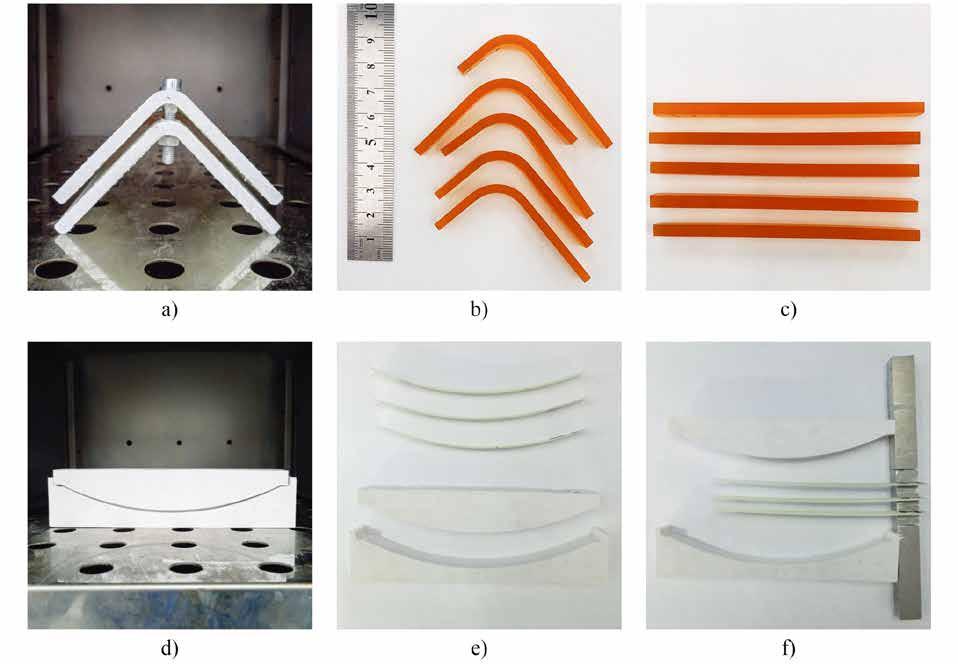
binations of geometries and mechanical properties, impossible to produce with other methods. The Skoltech scientists investigated the shape memory behavior and mechanical characteristics of epoxy-based pultruded flat laminates reinforced with unidirectional glass fibers. The analysis also encompassed the resin cure kinetics and the thermomechanical and thermophysical properties of the
cured resin. The findings may be used for further numerical simulations and the optimization of the pultrusion process. Besides, the results demonstrate that pultruded SMPCs show significant promise for structural applications.
The results are online>
Skoltech>
27 | INNOVATIVE MATERIALS 6 2021 RESEARCH
Dutch Design Week 2021
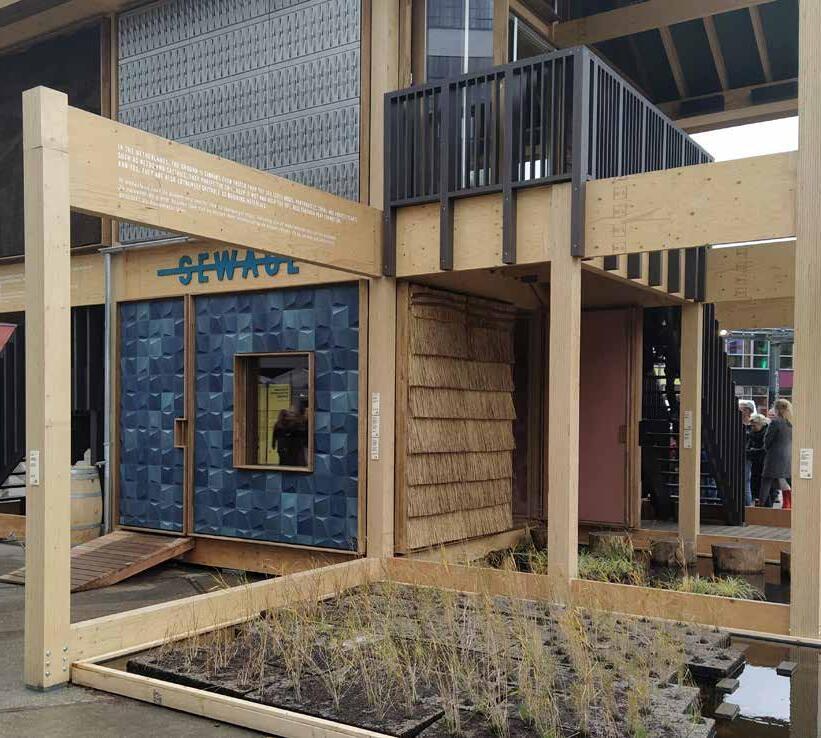
Every year in October the Dutch Design Week (DDW) takes place in Eindhoven. Between 16 and 24 October, the largest design event in Northern Europe presented the work of over a hundred designers, spread over more than a hundred locations in the city. With the theme The Greater Number, Dutch Design Week (DDW) called for a critical look at our way of producing and consuming this year. The largest design festival in Northern Europe showed how much designers are trying to find the right balance, towards less or towards more but better. And again this year attention is paid to material innovations, 3D-printed materials and objects, biomaterials and above all a lot of circularity.

28 | INNOVATIVE MATERIALS 6 2021
With Exploded View Beyond Building, Biobased Creations presented a lifesize biobased house together with 100 pioneers from the world of circular and biobased construction
The MINI Vision Urbanaut presented a whole new view on mobility and an innovative vision on the use of space (Click here for More at DDW>)
Biobased building


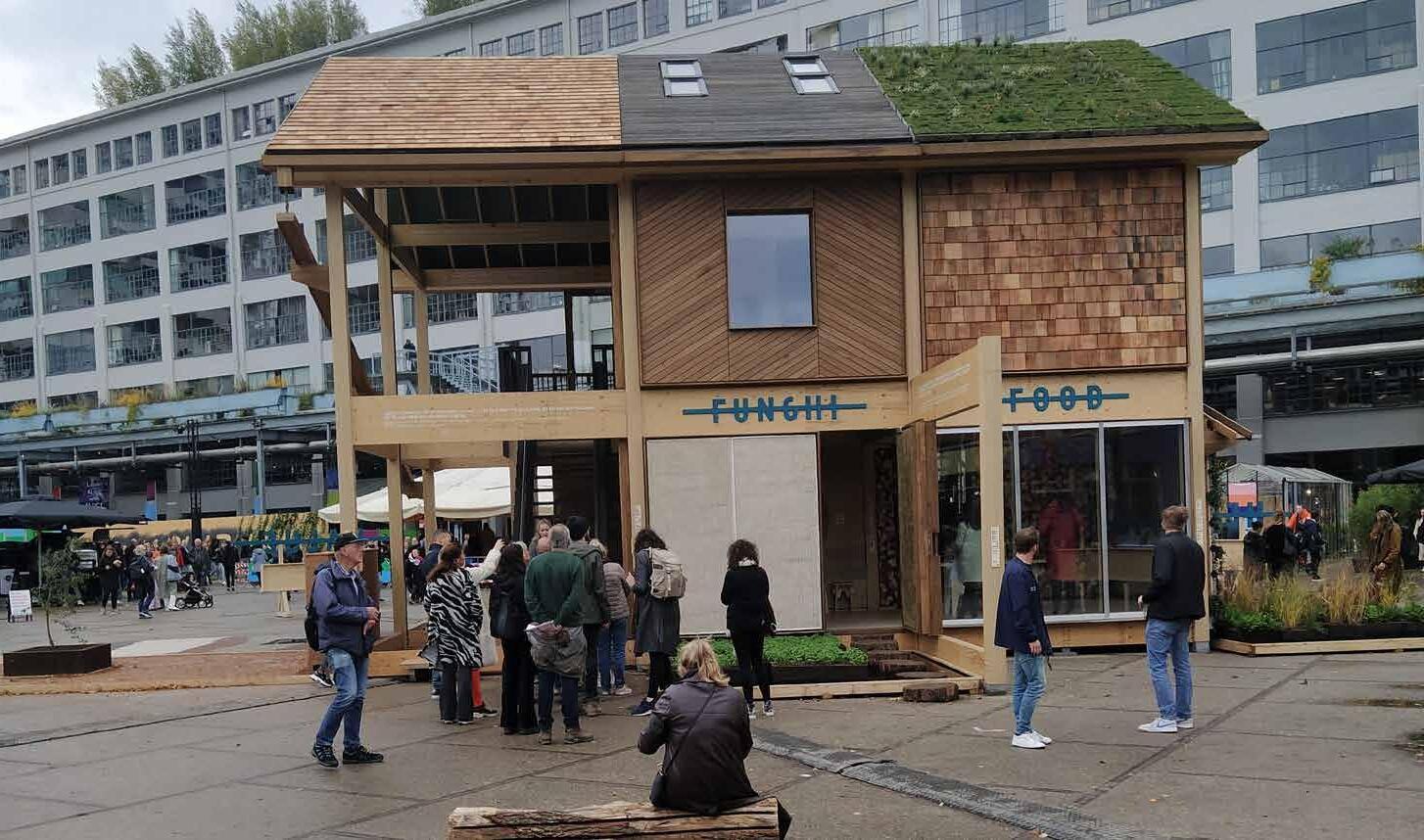

'Experience your circular living environment of the future' with this message, Biobased Creations presented The Exploded View Beyond Building. It involves a house that consists entirely of biobased materials, and is built with circular construction methods. A large number of potential building materials were presented that are available on a large scale, but are not yet or hardly used in the construction world. For example, materials from foodstuffs, seaweed, (sewage) water, soil, mushroom mycelium or more.
The Exploded View Beyond Building is the result of collaboration and research by builders, producers, farmers, scientists, designers, governments, knowledge institutes, storytellers and artists who are united in The Embassy of Circular & Biobased Building. Together they work on new perspectives for sustainable (circular and biobased) building and for living; a circular living environment. They are researching the possibilities of new biobased materials with a high design quality and circular construction methods such as detachability and modularity. They also look at how more worlds, than just the building world, are
influenced if they are designed and built differently.
Exterior facade of the Biobased Building with Nabasco 8010 biocomposite tiles made by NPSP. The tiles are made from reed grass clippings, cellulose fibers from recycled toilet paper that is recovered from sewage sludge at water treatment plants (Recell), softening lime, a by-product from the drinking water process, and a partial bio resin made from residual materials from biodiesel production. Natural dyes from blue-green algae and indigo are added in different proportions, resulting in different colour shades.
29 | INNOVATIVE MATERIALS 6 2021 DUTCH DESIGN WEEK 2021
DDW The Embassy of Circular & Biobased Building >
Video: the biobased building
Bio-based non-load-bearing partition walls
During the Dutch Design Week (DDW), attention was paid to a sustainable circular partition wall made of mycelium, developed by Bob Geldermans, TU Delft Architecture. The background of Geldermans' work was a concept that architect John Habraken introduced in the 1960s. His idea was that residents should be able to organize their homes themselves without much effort, depending on the phase in their housing career. This so-called Open Building concept was appreciated worldwide, but unfortunately rarely implemented. Bob Geldermans, who specializes in reuse and natural building materials, wanted to change that. He believes that removable, non-load-bearing interior walls in homes fit seamlessly into Habraken's concept. Homes with such walls can easily be adapted to changing housing needs, and that also applies to non-residential buildings. Geldermans, however, did not opt for traditional building materials, but
wanted to develop walls made of circular and non-harmful materials in order to contribute to making construction more sustainable.

Fibres and mycelium
The final chapter of his dissertation on demountable partitioning in homes contains a design proposal that he created for a straightforward wall module consisting of two side panels and a filling with insulation materials. For the side panels, cellulose residues are suitable. These could be clean fibres extracted from, among others, the textile industry, the cardboard and paper industry and agriculture. This has already been applied in packaging and in furniture. For insulation Geldermans used the filamentous network of fungi, mycelium. This filamentous network can grow in a controlled manner in moulds mixed with agricultural fibres for reinforcement, without the need for additives.

Together with former TU Delft student Daan Bruggink, founder of ecological architectural firm ORGA Architect and specialized in natural building, Geldermans developed a wall module with blocks of 40 x 60 cm. The format of the blocks has been taken from easily manageable collapsible hollow cassettes. The cassettes are made of panels and fitted with U-profiles in which the mycelium blocks are placed.
The project was realized in collaboration between Orga architect, Pluspunt, ECOR, Ekotex, Fairm, Quickpanell, CircuWall.
Geldermans' research - Securing Healthy Circular Material Flows In The Built Environment: The Case Of Indoor Partitioning - is online>
TUDelft>
30 | INNOVATIVE MATERIALS 6 2021 DUTCH DESIGN WEEK 2021
Photography: TU Delft
Printing with wood
Wood waste as a valuable fibre alternative. The project Printing with wood Lorenzo Hoorn explores the opportunity to replace synthetic fibres with renewable ones in 3D printed plastic objects. Using large printers, industrial waste materials of wood and thermoplastics are crafted into unique objects bearing a sustainable message.
Lorenzo Hoorn is a Dutch designer who recently graduated from the Integrated Product Design Masters at TU/Delft. His work focuses on combining his interest in sustainability, materials and technology.

To be able to 3D print large objects from thermoplastics, the material needs to be reinforced with fibres. These fibres are often synthetic, made from glass or carbon. This research explored the possibilities of using natural fibres instead and defining the unique material and sustainability properties of printed wood fibre reinforced thermoplastics. The advantage of using wood fibres is that it is a natural and widely abundant replacement for synthetic fibres. Because the wood fibres come from
industrial waste streams, like sawing and milling, the environmental impact compared to synthetic fibres is almost zero. On top of that, by using around a 60-70% of wood in the compound, the need for plastic material is reduced by half, making it even more beneficial.
The master thesis of Lorenzo was published titled: ‘Exploring the possibilities of Large-Scale Additive Manufacturing With Wood-Plastic Composites.’ It's online>


31 | INNOVATIVE MATERIALS 6 2021 DUTCH DESIGN WEEK 2021
More at DDW>
Photo's: DDW
Radiolaria #1

A 3D-printed chair, made of one single material, which combines all desired functionalities: flexibility, adaptability, firmness and stability. Product designer Lilian van Daal is investigating ways to innovate by making use of the laws of nature. She experiments with innovative technologies and materials to closely imitate nature.


The microorganisms Radiolaria and Bryozoa form the main source of her inspiration. Radiolaria are unicellular organisms that are found as zooplankton throughout the ocean and take their name from the radial symmetry of their

32 | INNOVATIVE MATERIALS 6 2021 DUTCH DESIGN WEEK 2021
Photography above/below: DDW
Video
skeletal spines. The structure of Radiolaria amplified by 3D printing affords various levels of flexibility and comfort without using different types of foam like in common soft seating. Bryozoa are moss animals that live in tropical waters and freshwater environments. The lattice of connections within Bryozoa skeletons inspired Van Daal to create a system of connection points for assembly of the chair without extra materials such as glue. In general, the leading principle in Radiolaria #1 is formed by symmetry which is also the main characteristic in all unicellular organisms.

Radiolaria #1 was produced by Oceanz 3D printing which provides cutting edge machines with which structures can be created that mimic natural solutions for durability, flexibility and connectivity on a microscopic level. The result is a blend of technology, design and nature.

Radiolaria #1 is a successor to Van Daal’s graduation project Biomimicry Soft Seating presented four years ago. Since the very first soft seating project, production time and energy consumption have both been decreased by 50% due to optimizations in the design that allow all elements of one chair to fit in one production run of the 3D printing machine.
DDW>
De Bond voor Materialenkennis (BvM) is een netwerk van experts op het gebied van materiaaltechnologie. Leden zijn onderzoekers en technici bij universiteiten, hogescholen, onderzoeksinstituten en de industrie. Het doel van de BvM is om kennis van de verwerking en toepassing van materialen te verspreiden, binnen en buiten het materialenveld.

De BvM initieert symposia, cursussen, technisch-wetenschappelijke publicaties, onderzoeksactiviteiten en bevordert de educatie in materialen. De totale aangeboden technologische kennis van ieder deelgebiedmetalen, kunststoffen, keramiek, biogebaseerde materialen, lasertechnologie, verbindingen, verftechnologie, reologie, tribologie, corrosie, warmtebehandelingstechniek, duurzaamheid en betrouwbaarheid - maakt de BvM een krachtige beroepsorganisatie in Nederland en België.
Voordelen van het lidmaatschap van de BvM:
Gratis studentenlidmaatschap: Vertel het verder!
BvM-leden genieten van het FEMS- en het EFC-lidmaatschap van de BvM
FEMS is de Federation of European Materials Societies
EFC is de European Federation of Corrosion
Korting op activiteiten van de BvM
Toegang tot een groot materialennetwerk
Kijk voor meer informatie en contact op de nieuwe website van de Bond voor Materialenkennis: https://www.bondvoormaterialenkennis.nl/

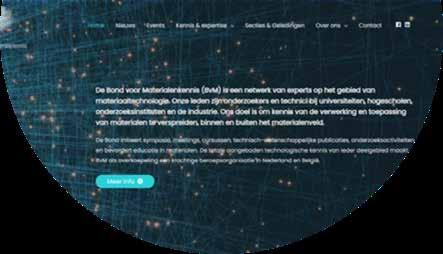
33 | INNOVATIVE MATERIALS 6 2021 DUTCH DESIGN WEEK 2021
Unito: CO 2 utilization in design

What can designers do about CO2 already present in the atmosphere? That's the question Riel Bessai asked himself. Riel Bessai is a designer from Canada. His work focuses on climate change, sustainability, and circularity. He graduated last summer at Delft University of Technology, Integrated Product Design on the project ‘The artificial carbon sink: Using products to fight climate change.’
With the Unito-presentation at the DDW Riel Bessai explores the concept of carbon dioxide utilization, which considers CO2 as a feedstock to produce materials. By using these materials in products, the act of production leads to removal of CO2 from the atmosphere and its storage inside the built environmentan artificial carbon sink.

Unito is a so-called ‘modular system’ architecture that can be used to build functional objects which store CO2. It consists of units built from carbon-negative bio-HDPE. Each unit contains 1 kg of organic carbon which is derived from 3 kg of atmospheric CO2. The units are joined together by a family of connectors to create products.
Unito is designed for longevity. The units are designed to store carbon for hundreds of years, while the assembled objects can be disassembled and reconfigured to address unanticipated user needs. Ultimately, the biopolymer can be recycled or stored.

Unito is still a speculative concept, according to Bessai, intended to spark a discussion about a world made up of materials made of atmospheric CO2 and about how designers can contribute to combating the climate crisis.
DDW>
34 | INNOVATIVE MATERIALS 6 2021 DUTCH DESIGN WEEK 2021
Illustration: TU Delft/DDW
WasteBasedGlazedBricks
Studio Mixtura started a new collaboration with StoneCycling this year to develop a new range of glazes from waste and apply them to the company's already existing WasteBasedBricks. This resulted in a new collection of fully circular glazed bricks - WasteBasedGlazedBricks - that can be used in facades and interior walls, either as full bricks or as produced brick slips. They were presented at the Dutch Design Week, from 16 to 24 October 2021 in Eindhoven.
StoneCycling makes stones from waste. The company started in 2013 with the idea of reusing building materials, especially ceramics and glass. This led to a circular product - WasteBasedBricks.
Although WasteBasedBricks are based on a cradle to cradle philosophy to the; aesthetics are important as well. For some time now, the company has included a new brick and brick slips in the WasteBasedBricks oeuvre: the Shine series: bricks with an applied colour. Before the bricks go into the kiln, an extra layer of Shine is applied, which is a mix of recycled glass and other components. This results in a glazed product that, according to the manufacturer, provides a lively surface, which gives a facade a special appearance, especially in sunlight.
The Shine bricks should be seen as the next step towards a wider spectrum of glazed products. And so this year a new collaboration started with StoneCycling and Studio Mixtura to develop a series of glazes from waste.
Studio Mixtura was founded in 2015 by 'design chemist' Daria Biryukova with the aim of finding a smart new application for waste and secondary raw materials. The company says it helps other companies and organizations to review their production methods and waste management.
The activities of StoneCycling and Studio Mixtura have now led to a new product: WasteBasedGlazedBricks. The glazes were developed in collaboration with ABO Global, a company that specializes in valorising by-products. Waste streams were used, in particular from the metal and glass industry, which can usually be reused to a very limited extent and from which millions of tons are released every year. Ultimately, this led to six glaze colours - brown, yellow, blue, white, green and aubergine brown - which are applied to StoneCycling's existing WasteBasedBricks and WasteBasedSlips. With these glazes from waste, StoneCycling says it has taken the next step with completely circular, aesthetic building materials.
Project 'WasteBasedGlazedBrick' is supported by the Creative Industries Fund NL: the culture fund for design, architecture, digital culture and all possible crossovers.

StoneCycling WasteBasedGlazedBricks>
Studio Mixtura>
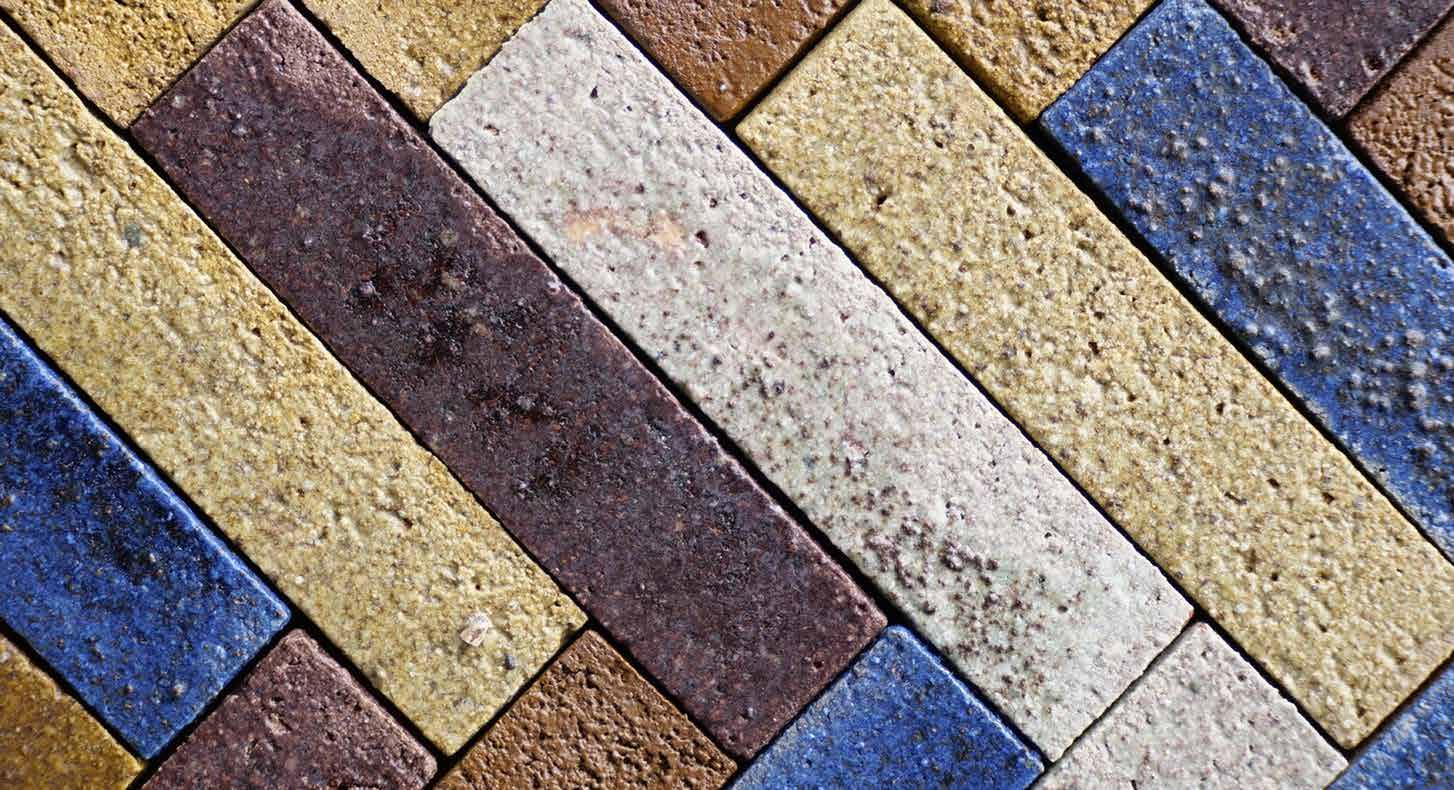
35 | INNOVATIVE MATERIALS 6 2021 DUTCH DESIGN WEEK 2021
Enterprise Europe Network (EEN) supports companies with international ambitions

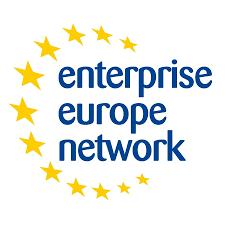
The Enterprise Europe Network (EEN) is an initiative of the European Commission that supports entrepreneurs in seeking partners to innovate and do business abroad. The Network is active in more than 60 countries worldwide. It brings together 3,000 experts from more than 600 member organisations – all renowned for their excellence in business support.
Database
Every company can participate by adjusting its profile to the database. This company will be brought to the attention in the country in which it wants to become active. At the same time it is possible to search for partners.
EEN advisers actively assist in compiling the profile, which is drawn up in a certain format. The EEN websites also contain foreign companies that are looking for Dutch companies and organizations for commercial or technological cooperation. The EEN advisers support the search for a cooperation partner by actively deploying contacts within the network. In addition, Company Missions
and Match Making Events are regularly organized. All these services are free of charge.
There are five types of profiles:
• Business Offer: the company offers a product
• Business Request: the company is looking for a product
• Technology Offer: the company offers a technology
• Technology Request: the company is looking for a technology
• Research & Development Request: the organization seeks cooperation for research
When a company has both a Business Offer and a Business Request (or another combination), two (or even more if applicable) profiles are created. The profile includes the most essential
information about the nature of the supply or demand, the ‘type of partner’ that is intended and the expected cooperation structure.
Get in touch with your local network contact point by selecting the country and city closest to where your business is based. They can help you with advice, support and opportunities for international partnerships.
For sustainable building and the creative industry, contact ir. drs. Hans Kamphuis:
T: +31 (0) 88 042 1124
M: 06 25 70 82 76
E: hans.kamphuis@rvo.nl
For Materials contact Nils Haarmans:
T: +31 (0) 88 062 5843 M: 06 21 83 94 57
More information websites can be found at the Europe Network websites:
www.enterpriseeuropenetwork.nl
http://een.ec.europa.eu

36 | INNOVATIVE MATERIALS 6 2021 ENTERPRISE EUROPE NETWORK
Video: How Enterprise Europe Network works
The Enterprise Europe Network Materials Database: Request for partnership: December 2021.
Interested? contact hans.kamphuis@rvo.nl>
A French company in the childcare industry is looking for eco-friendly plastics and packaging suppliers or manufacturers

A French company in the childcare industry is looking for eco-friendly materials (recycled and bio-based materials) in plastics and packaging industries. The company researches solutions for future development to include in their range of products for babies. The company wants to establish technical cooperation agreement or manufacturing agreement.
Italian start-up is looking for a partner with chemical expertise for optimizing the production and colouring process of tiles obtained from recycled organic materials


An Italian start-up specialized in the production of biodegradable furniture items obtained from organic waste materials is looking for a partner for developing sustainable tiles and improving their colouring process, under research cooperation agreement. The partner should have chemical expertise, and would analyse the waste materials used in the tiles' production and colouring process, to help solve the issues facing the currently developed tiles, such as their resistance problems to humidity.
A Czech company is looking for suppliers of PET flakes, PET shredded preforms or PET fines from European single market countries

A Czech company focusing on separating plastic regranulates and shredded plastics is looking for a suppliers of PET flakes, shredded PET preforms or PET fines. They provide reliable and speedy service for sorting of hard-to-sort materials based on advanced technologies. Cooperation would be based on services agreement.
Italian industrial group in the packaging sector seeks innovative, green materials to increase sustainability of its products
An Italian industrial group, a world leader in the packaging sector, is looking for start-ups or scale-ups offering innovative technological materials solutions to be applied to the packaging field, preferably at TRL 7, to increase sustainability of its products. Partners will work together in co-development and go-to-market strategy under technical cooperation agreement. This request is part of an open innovation challenges programme.
Romanian company seeks raw materials for production of funeral monuments and home decorations under supplier agreements
A company based in Romania is looking for raw materials for carving ornate funeral monuments and interior/exterior vertical and horizontal decoration and design. The company is looking for international partners capable of providing granite, marble, travertine, chalk, and onyx, regardless of country of origin under supplier agreements.

37 | INNOVATIVE MATERIALS 6 2021 ENTERPRISE EUROPE NETWORK
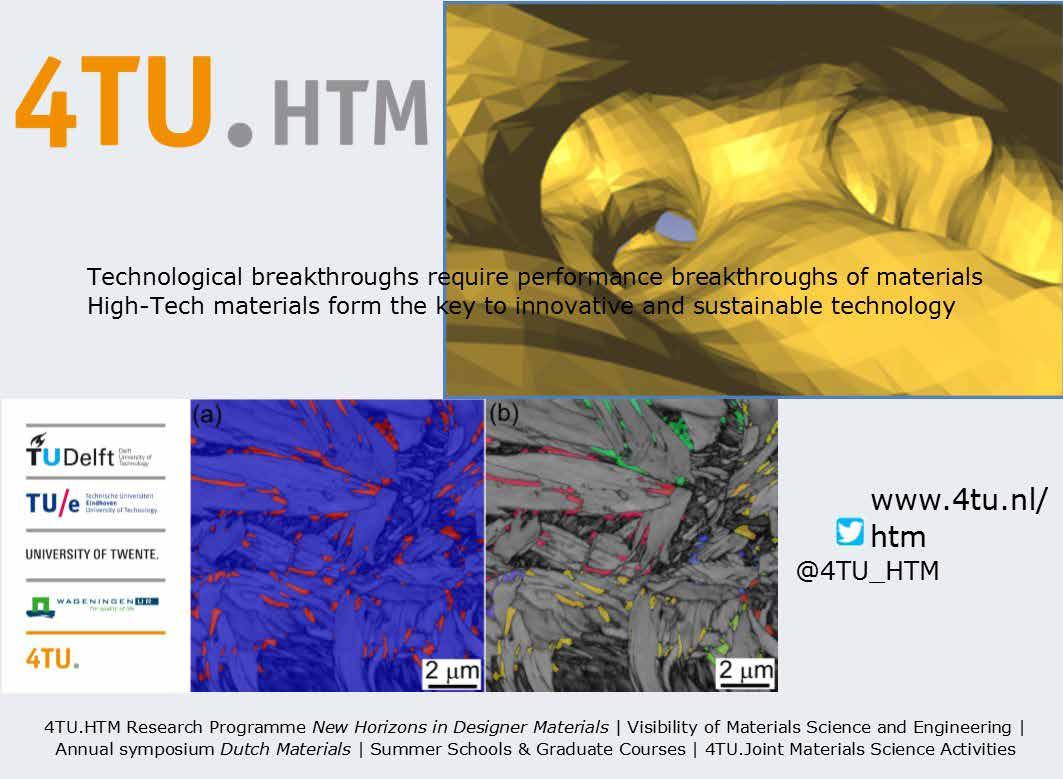
38 | INNOVATIEVE MATERIALEN 6 2021 NIEUWS
De NVDO Sectie Techniek organiseert in samenwerking met de Bond voor Materialenkennis op donderdag
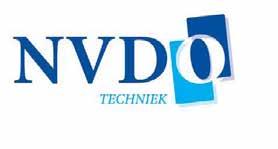

27 januaribij StorkThermeq in Hengelo;
“Biobased materialen; Wat betekent dat voorde Kennis over Onderhoud?”
In 2050moet Nederland volledig circulair zijn. Het gebruik van biobasedmaterialen zouo.a. kunnen bijdragen aan het verlagen van de CO2, maar waar moet je rekening mee houden wanneer jebiobased materialen gebruikt? Is er een groot verschil met ‘normale’ materialen met betrekking tot het gebruik, de veroudering en het onderhoud?
Programma(14.00-16.30 uur)
Ontvangst en Registratie
Welkom en Opening door de Dagvoorzitter; Jos Weekers; Senior Consultant bij Stork Asset Management Solutions en Voorzitter NVDO Sectie Techniek.
“Biobrandstoffenom energie op te wekken”

Martijn Hinderdael Senior Energy Consultant at Stork Thermeq
De vraag naar het gebruik van alternatieve (bio)brandstoffen wordt steeds groter. Bij installaties in verschillende industrieën zijn al aanpassingen gedaan om conventioneel gestookte stoomketels om te bouwen naar biobrandstof ketels. Zo’n transitie kan niet zomaar doorgevoerd worden. Martijn deelt de ervaringen bijtwee projectenen geeft inzicht in de keuzes die gemaakt zijn, de gevolgenvoor het onderhoud en inde succesfactoren voor een geslaagd biobrandstoffen project
Rondleiding Stork Thermeq en Netwerkpauze
Biologischafbreekbare smeermiddelen of Milieuvriendelijkeresmeermiddelen?
Kees Oskam Trainer/Consultant Van MeeuwenIndustries
Debehoefte aan biologische smeermiddelen wordt steeds groter, maarerzijn nog veel vragen over het gebruik. Kees geeft antwoord op:
-Wat zijn dit voor smeermiddelen en wat is de afbreekbaarheid hiervan?
-Wat zegt de wet-en regelgevinghierover?
-Welke schade brengteen conventioneel smeermiddel aanhet milieu?
-Kunnen wesmeermiddelen ook hergebruiken?
Inspiratie met het rode bankje
De Dagvoorzitterspreekt een senior-en juniorprofessionaluitde praktijk over de toepassing van biobased materialen. Hierin is er ruimte voor de zaal om gezamenlijk de dialoog aan te gaan Henk Jonkers onderzoekt de ontwikkeling van innovatieve, biobased en duurzame bouwmaterialen en is wetenschappelijk adviseur van TU Delft spin-off bedrijf Basilisk
Pablo Borkes richtte zich tijdens zijn afstudeerstage op de ontwikkeling van Grasfalt, eeninnovatief asfaltmengsel waarbij bitumen is vervangen door hetbiobased bindmiddel lignine dat afkomstig is uit olifantsgras
Aanmelden klik hier!
(*) Deelnemers kunnen aantonen dat ze Coronavrij zijn (via test, niet ouder dan 48 uur, of via de Corona Checkapp)
EVENTS 39 | INNOVATIVE MATERIALS 6 2021
Meeting Materials 2021

Postponed to 5 April 2022, Noordwijkerhout
This year’s session topics will be:
• Engineering materials (including additive manufacturing and steel manufacturing)

• Sustainability
• Artificial Intelligence in materials modelling and manufacturing
• Advanced Materials Characterisation
• Metamaterials (4TU.HTM session)

Elevator Pitches
SMEs (MKB) or start-ups involved in materials development are invited to participate in the yearly Elevator Pitch session. An unique opportunity to catch the attention of a very diverse audience with a 90 seconds presentation.
What began in 1997 as an annual meeting for the Dutch materials science community, existing of a dozen researchers, students and industrial partners has blossomed into an invigorating event about innovations in materials. This year we again expect over 300 participants, representatives from SME’s to renowned industrial manufacturing companies, and from international universities and research institutes. This year the Program consists of interesting workshops and presentations and of course a lot of opportunities to expand your network.
M2i Meeting Materials 2021 is free of charge and open for everyone who is interested in materials development. The conference is an opportunity to learn about the latest insights and developments in the field of innovative and smart materials, along with ways in which these materials can stimulate economic progress and a sustainable society. This day is co-organized with 4TU.HTM and supported by the Bond voor Materialenkennis (BvM)
Registration for the new date will open mid January.
Exhibition of expertise
All participants in the Elevator Pitch session will get the chance to display their products and services in the central conference hall throughout the conference. Great opportunity to network with the audience.

Interested in joining the Elevator Pitch session? Please email your input to conference@m2i.nl>
More at M2i>
EVENTS 40 | INNOVATIVE MATERIALS 6 2021
Meeting Materials 2019 (Foto: M2i)
The corona crisis makes it uncertain whether events will actually take place on the scheduled date. Many events are postponed or online. The Agenda below shows the state of affairs as of December 2021. For recent updates: www.innovatievematerialen.nl
Solids 2022

16 - 17 February 2022, Dortmund
Ulmer Betontage 2022
22 - 24 February 2022, Ulm
JEC World 2022
8 - 10 March 2022, Paris-Nord
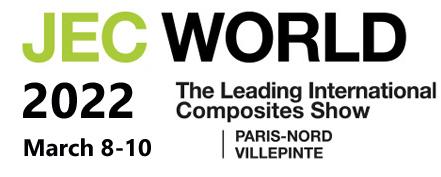
BLE.CH 2022
8 - 10 March 2022, Bern
ESEF 2022
15 - 18 March 2022, Utrecht
Meeting Materials

4 - 5 April 2022, Noordwijkerhout
Material District

5 - 7 April 2022, Utrecht
Nordbygg 2022

26 - 29 April 2022, Stockholm
FIT Show 2022 10 - 12 May 2022, Birmingham

Glasdag 2022

9 of 16 June 2022, Leusden
SurfaceTechnology GERMANY, 21 - 23 June 2022, Stuttgart
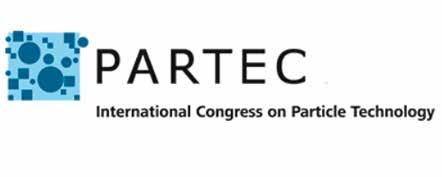



Ceramitec 2022

21 - 24 June 2022, Munich
Glasstec 2022

20- 23 September 2022, Düsseldorf
Bioceramics32
20 - 23 September 2022, Venetië
Holz 2022
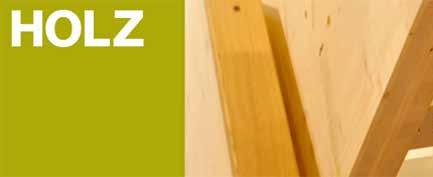
11 - 15 October 2022, Basel
K Messe Düsseldorf
19 - 26 October 2022
EuroBLECH 2022,

25 - 28 October 2022, Hannover
VETECO 2022

15 - 18 November 2022, Frankfurt am Main

Münchener Forum Verbindungstechnologie 2022

23 - 24 November 2022, Munich
Fastener Fair Stuttgart



21 -23 March 2023, Stuttgart
Moulding Expo 2023
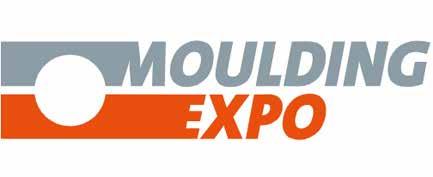
13 - 16 June 2023, Stuttgart
Partec 2023
26 - 28 September 2023, Nürnburg
EVENTS 41 | INNOVATIVE MATERIALS 6 2021
Innovative Materials, the international version of the Dutch magazine Innovatieve Materialen, is now available in English. Innovative Materials is an interactive, digital magazine about new and/or innovatively applied materials. Innovative Materials provides information on material innovations, or innovative use of materials. The idea is that the ever increasing demands lead to a constant search for better and safer products as well as material and energy savings. Enabling these innovations is crucial, not only to be competitive but also to meet the challenges of enhancing and protecting the environment, like durability, C2C and carbon footprint. By opting for smart, sustainable and innovative materials constructors, engineers and designers obtain more opportunities to distinguish themselves. As a platform Innovative Materials wants to help to achieve this by connecting supply and demand.


Innovative Materials is distributed among its own subscribers/network, but also through the networks of the partners. In 2021 this includes organisations like M2i, MaterialDesign, 4TU (a cooperation between the four Technical Universities in the Netherlands), the Bond voor Materialenkennis (material sciences), SIM Flanders, FLAM3D, RVO and Material District.



